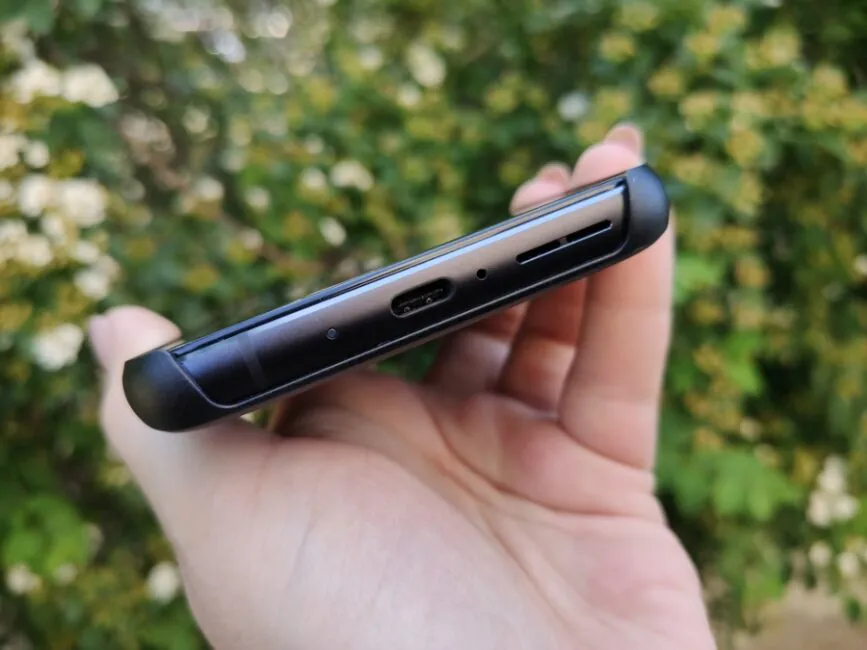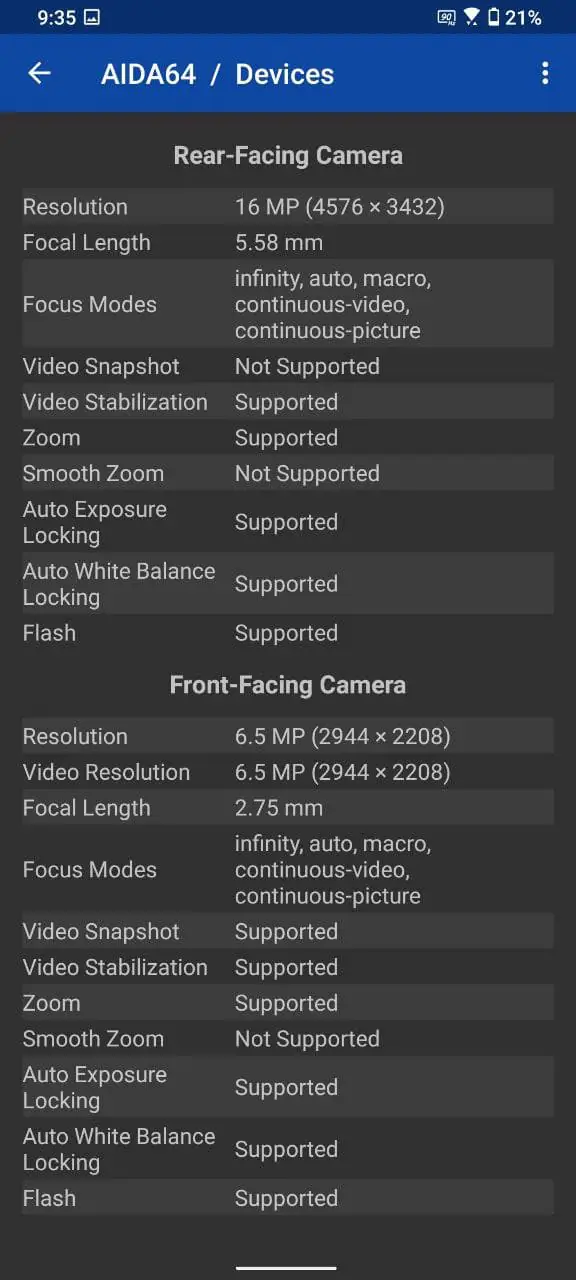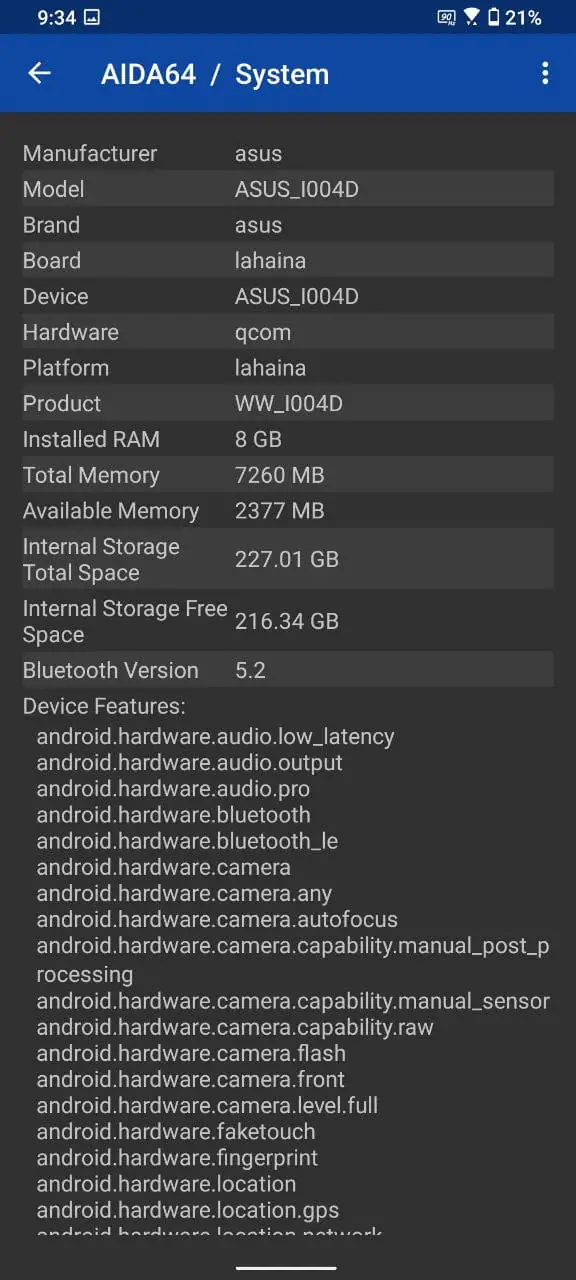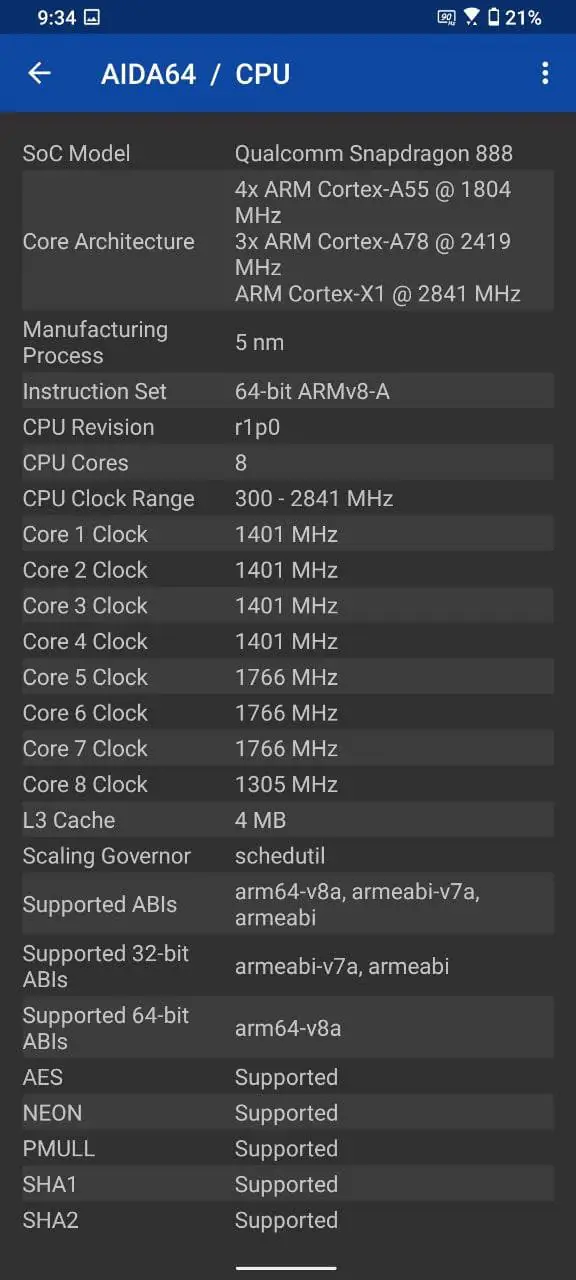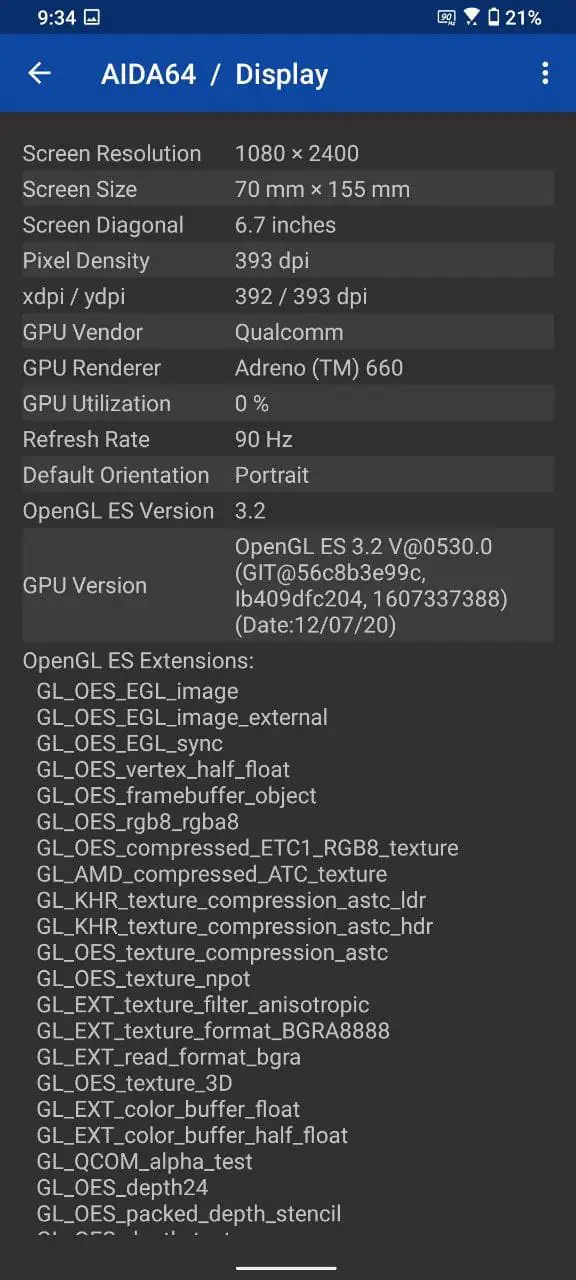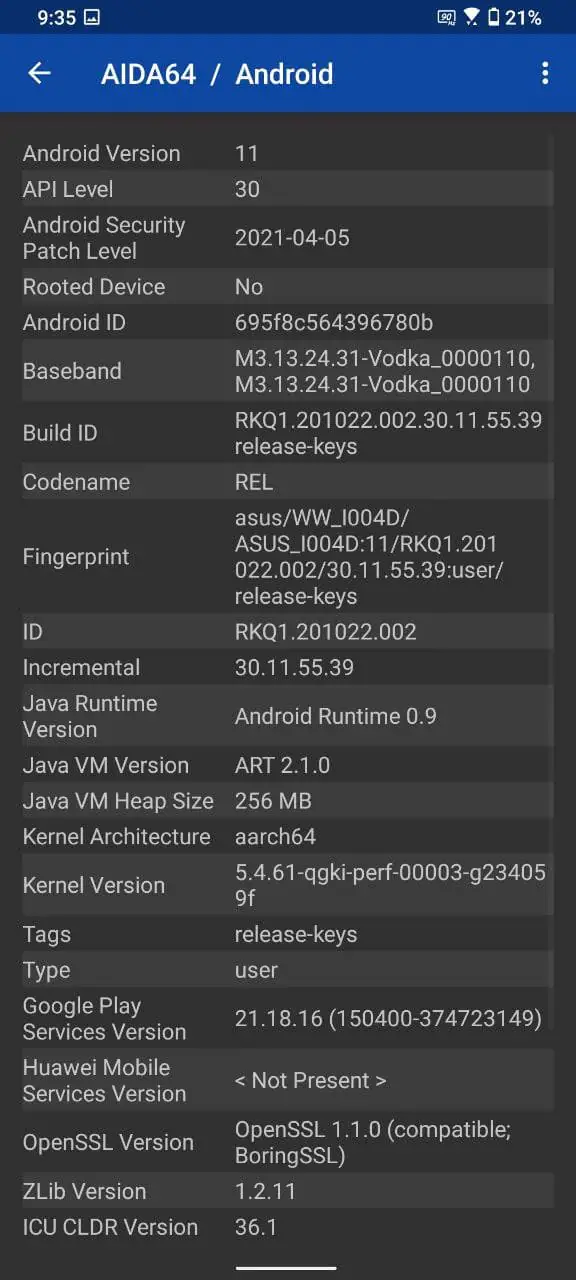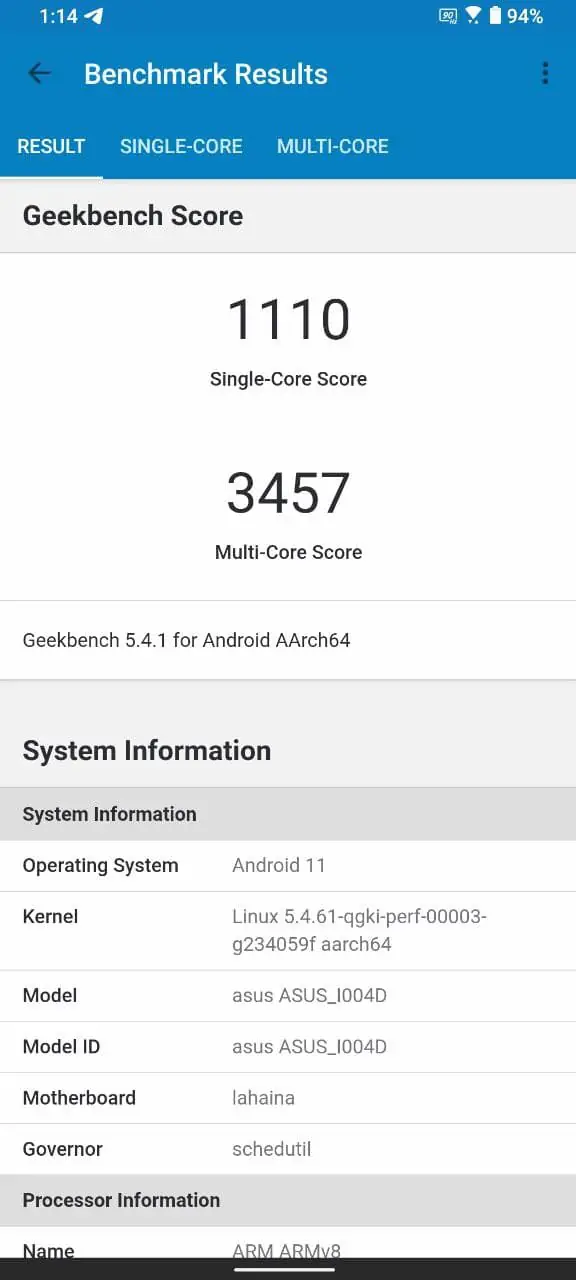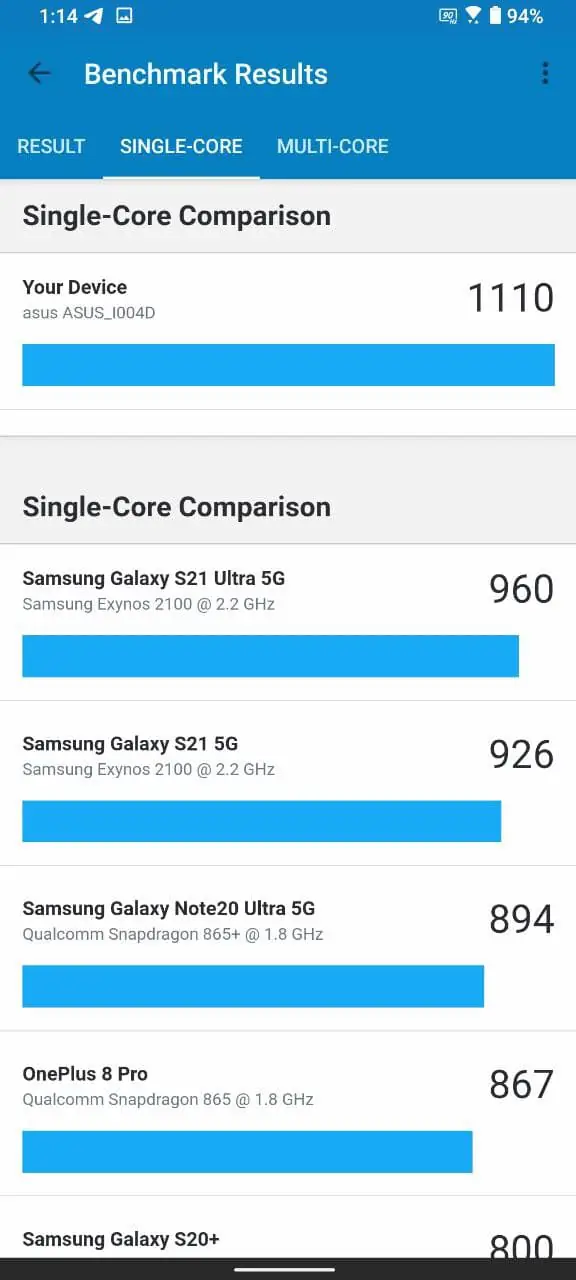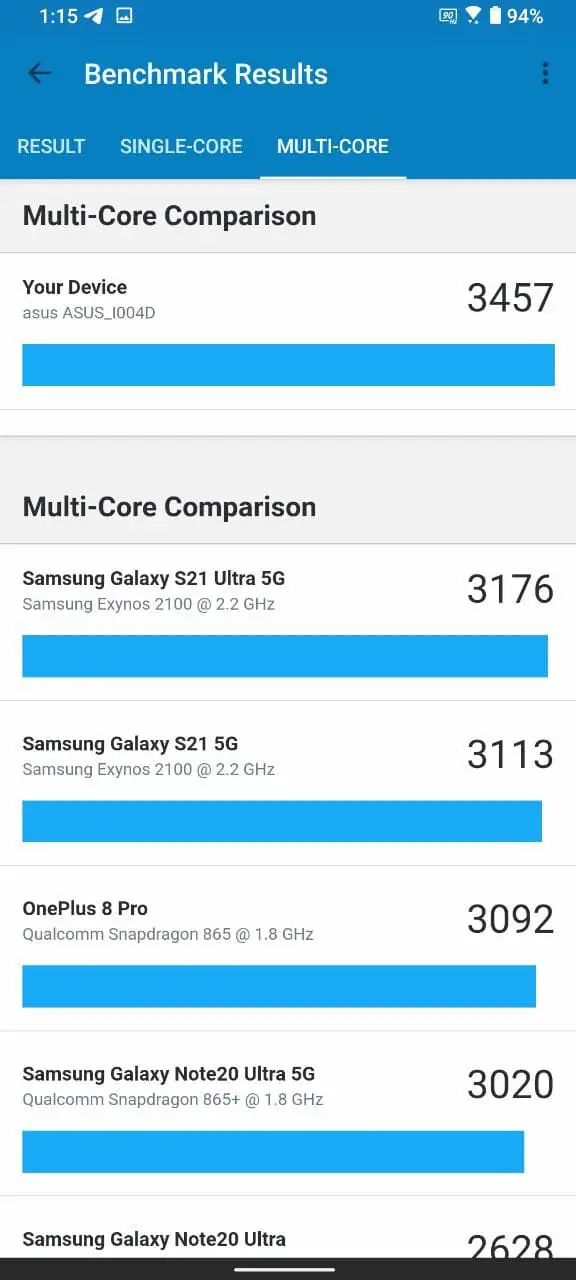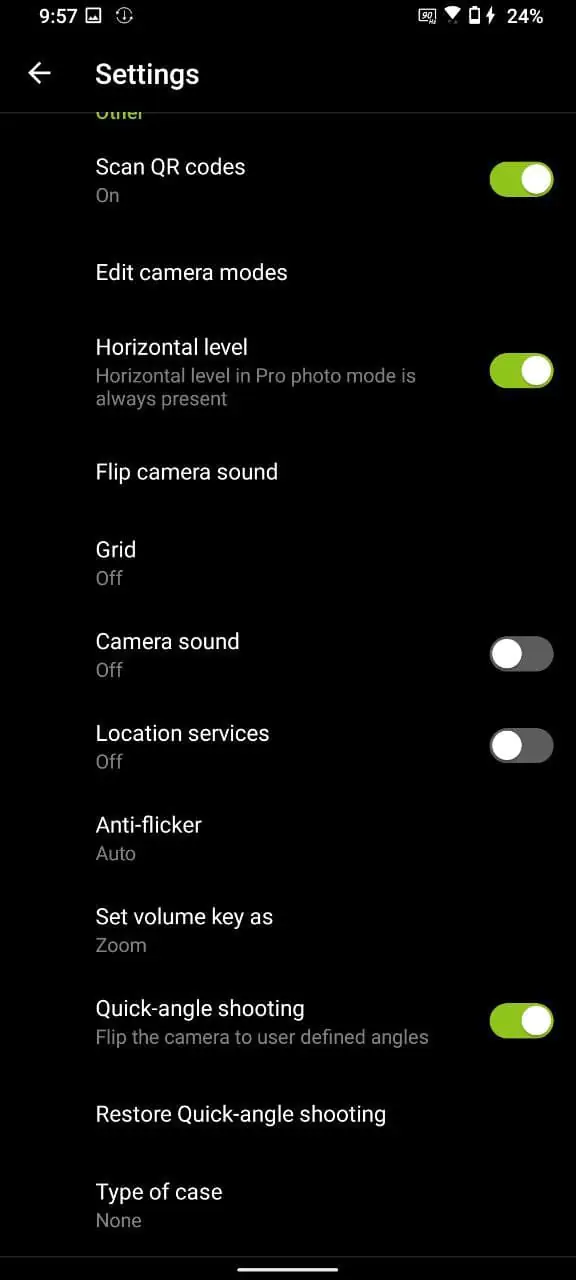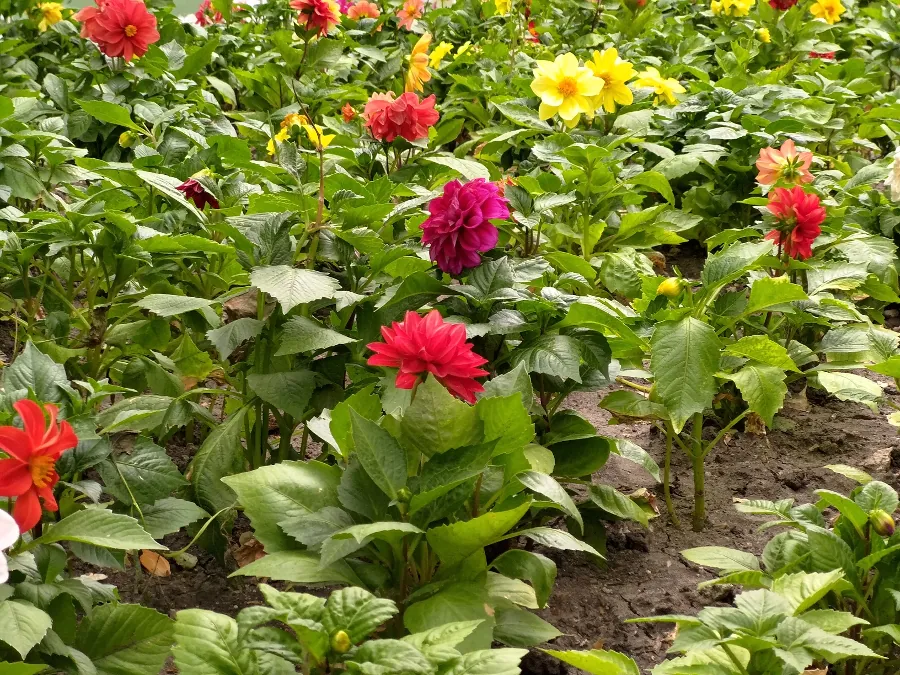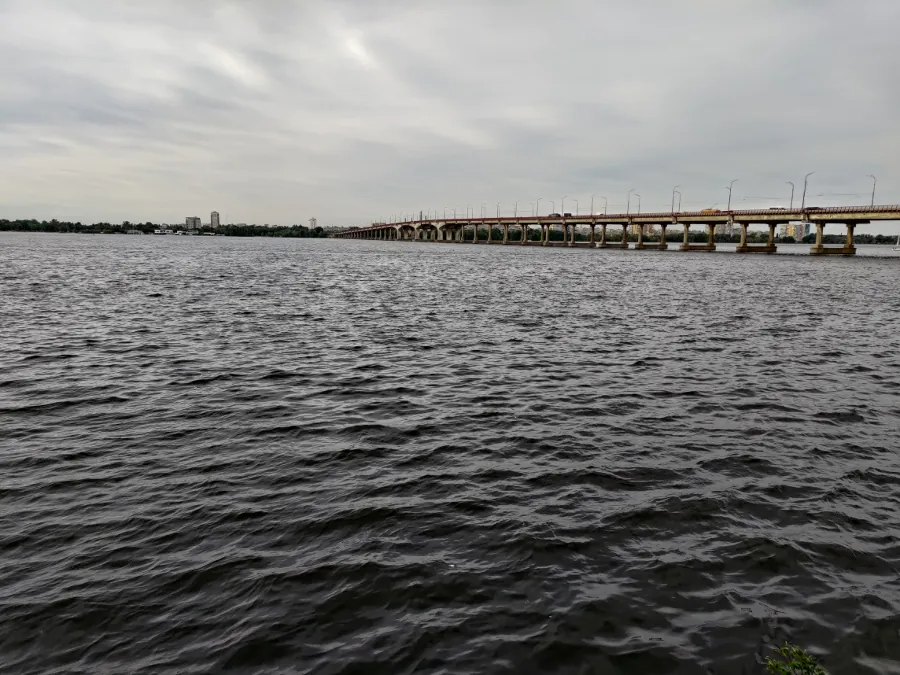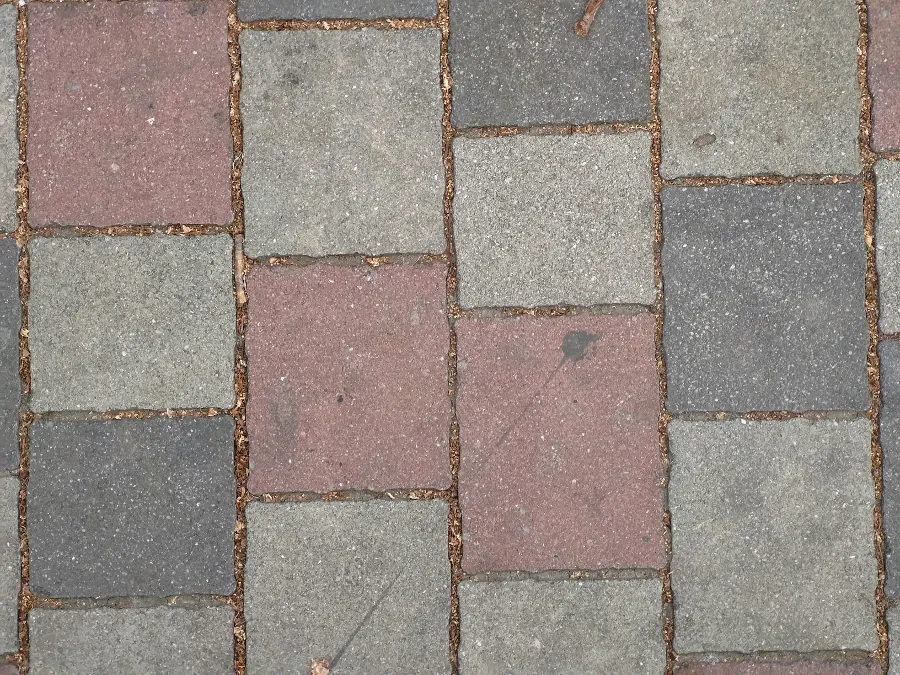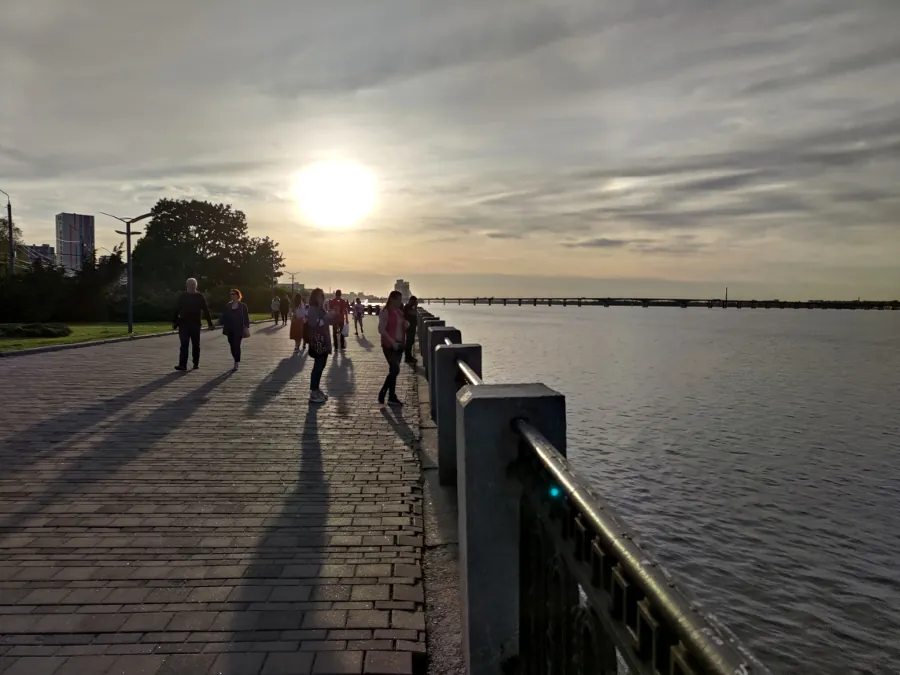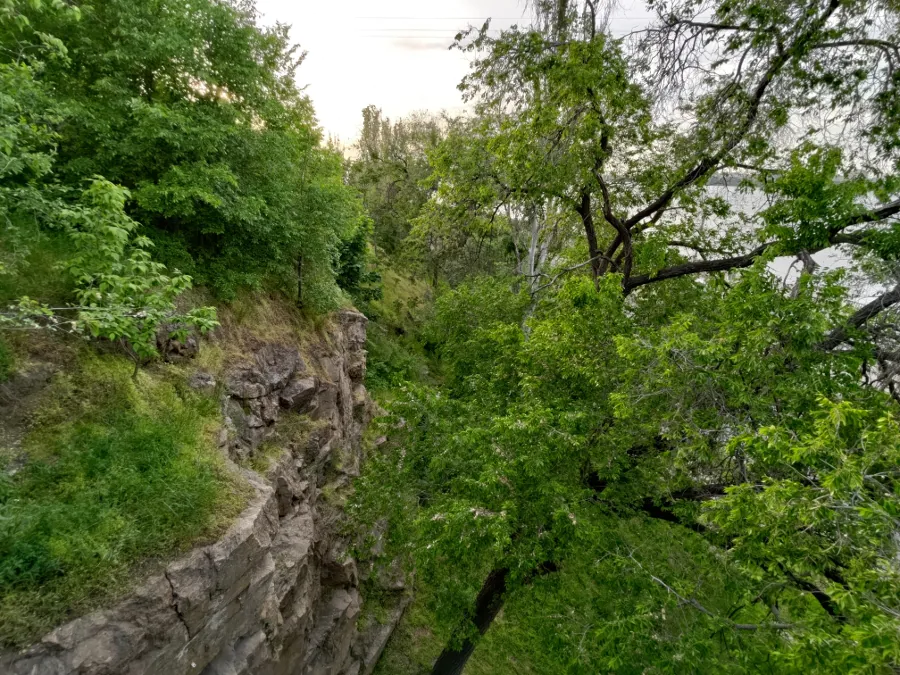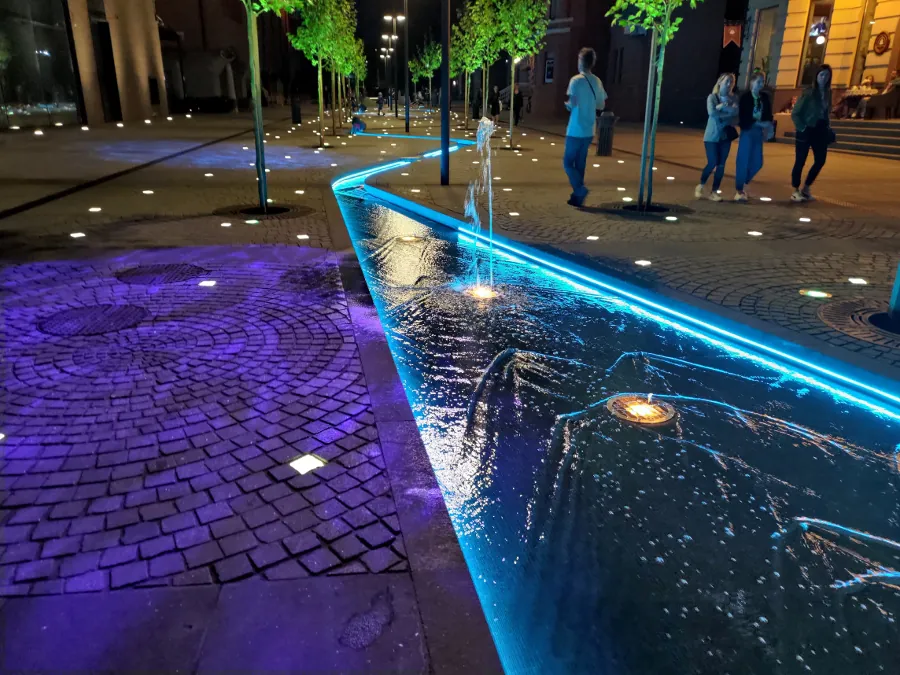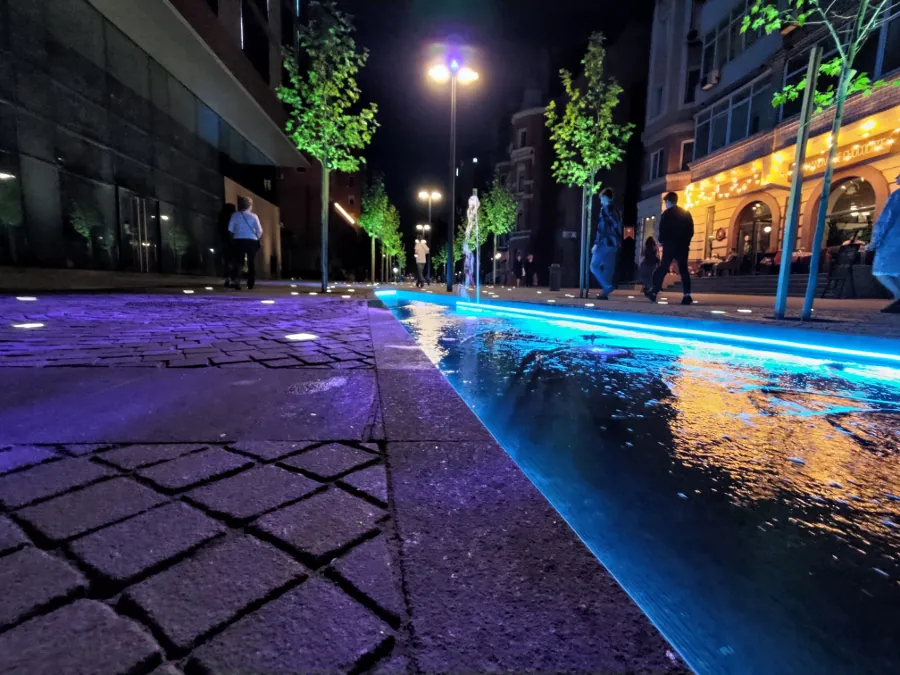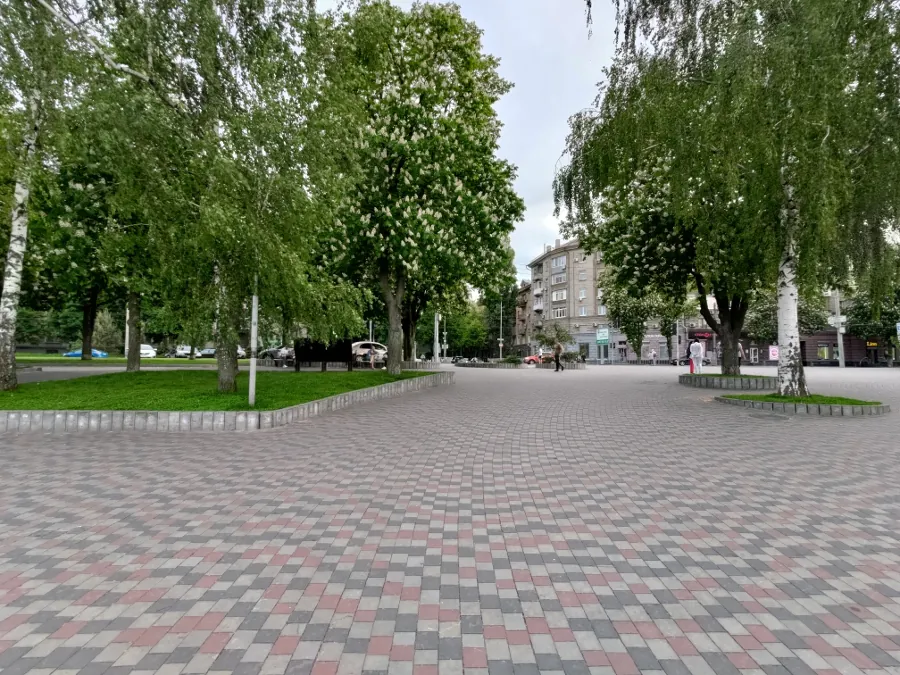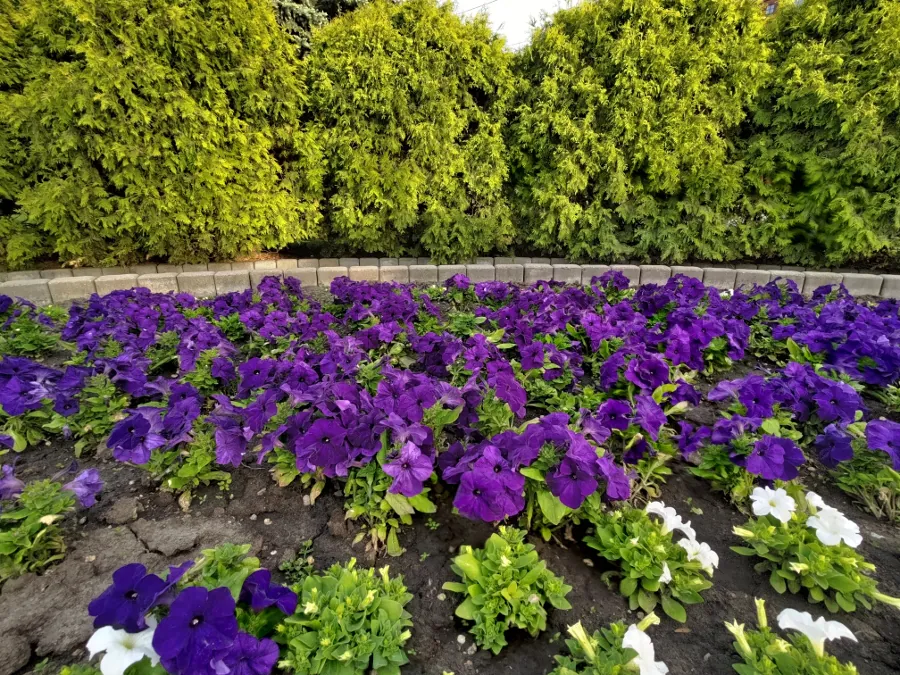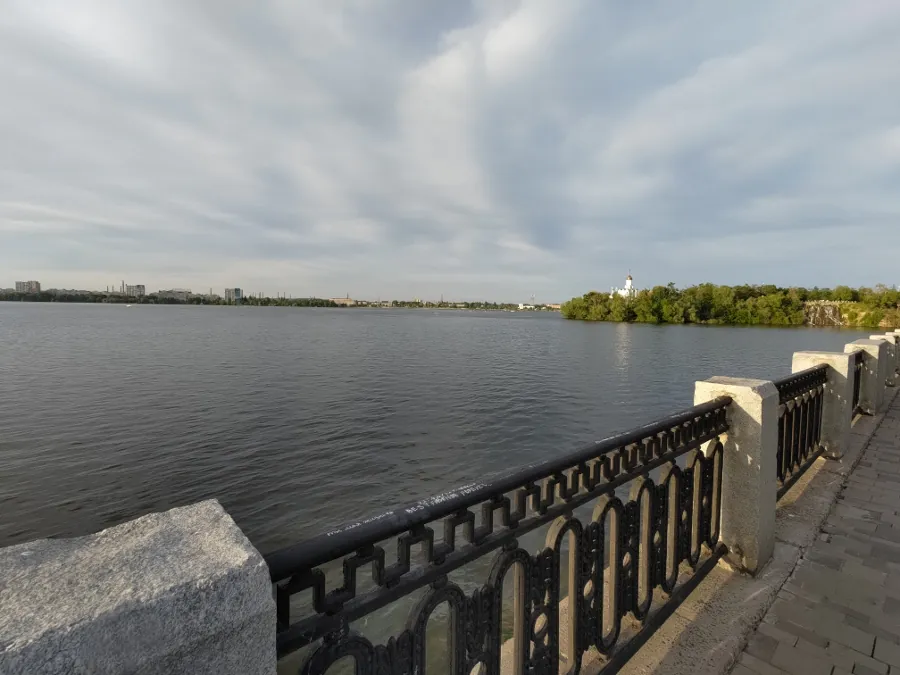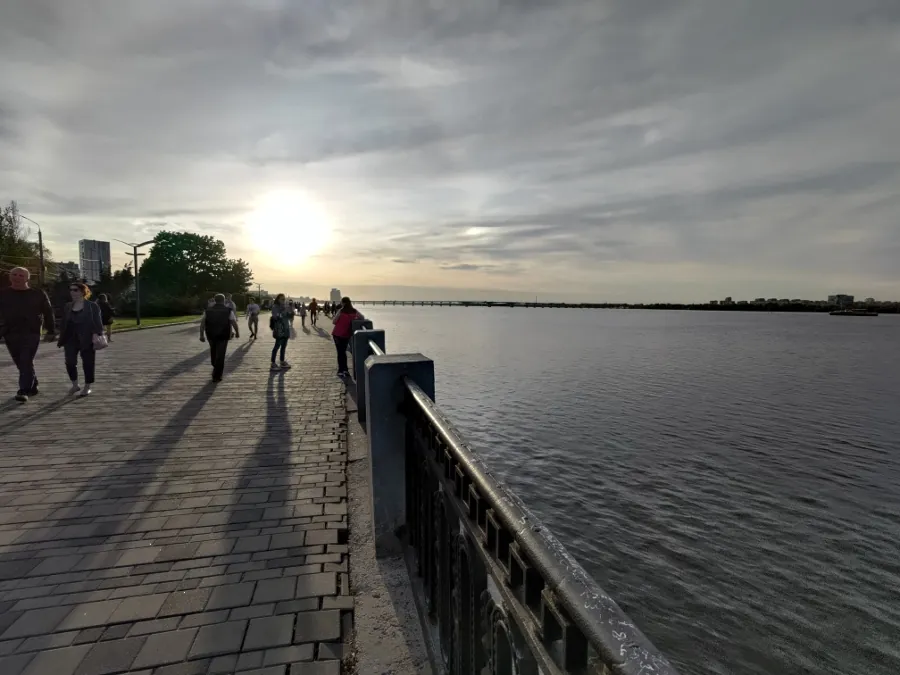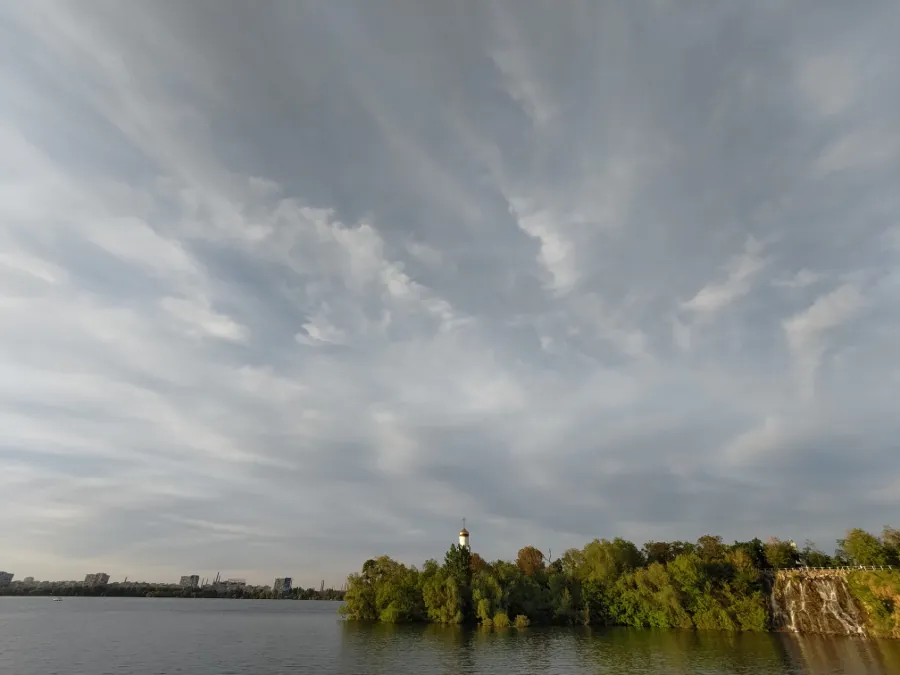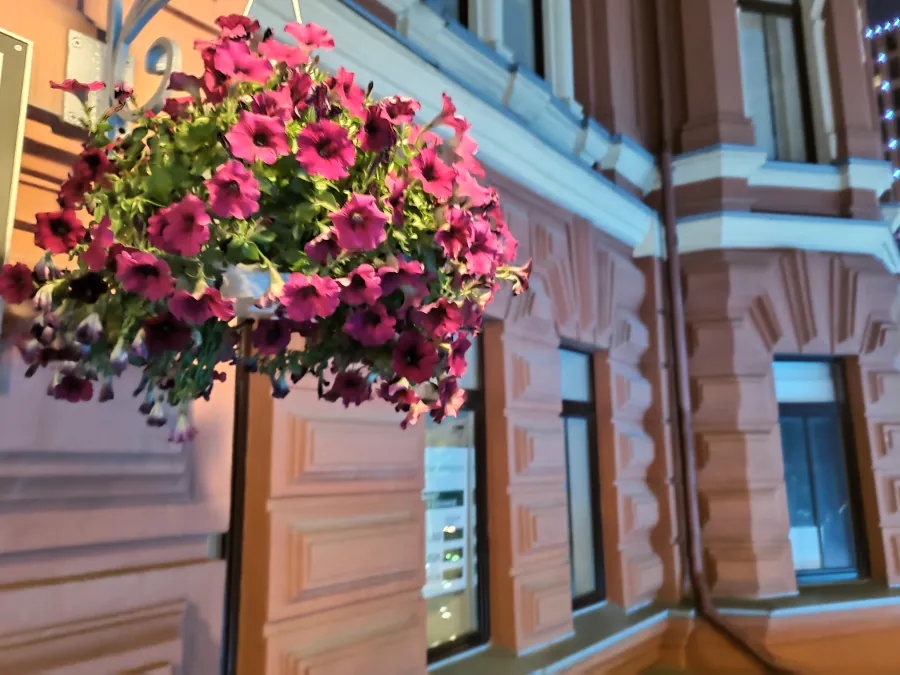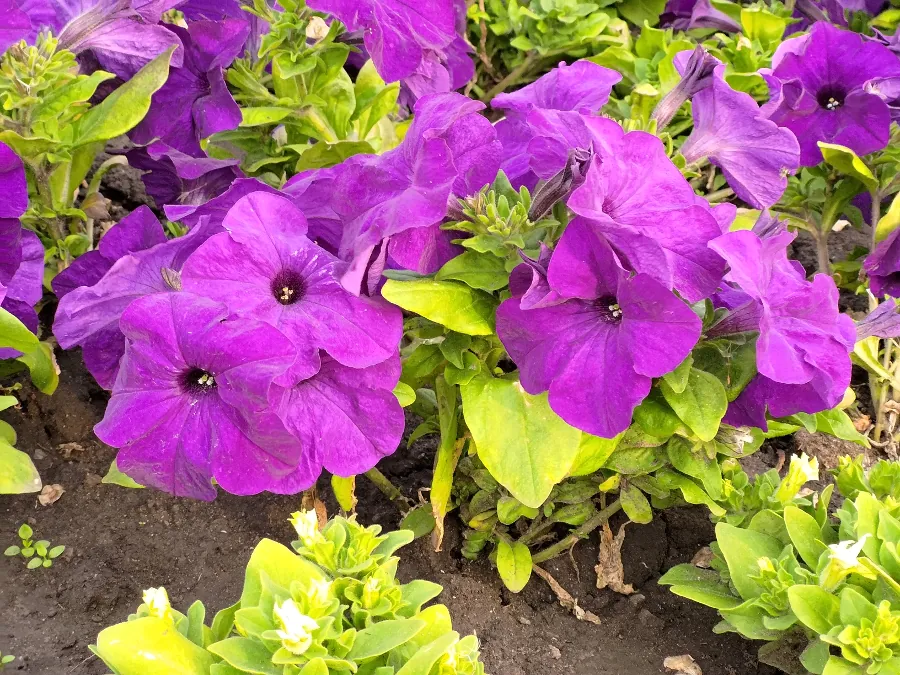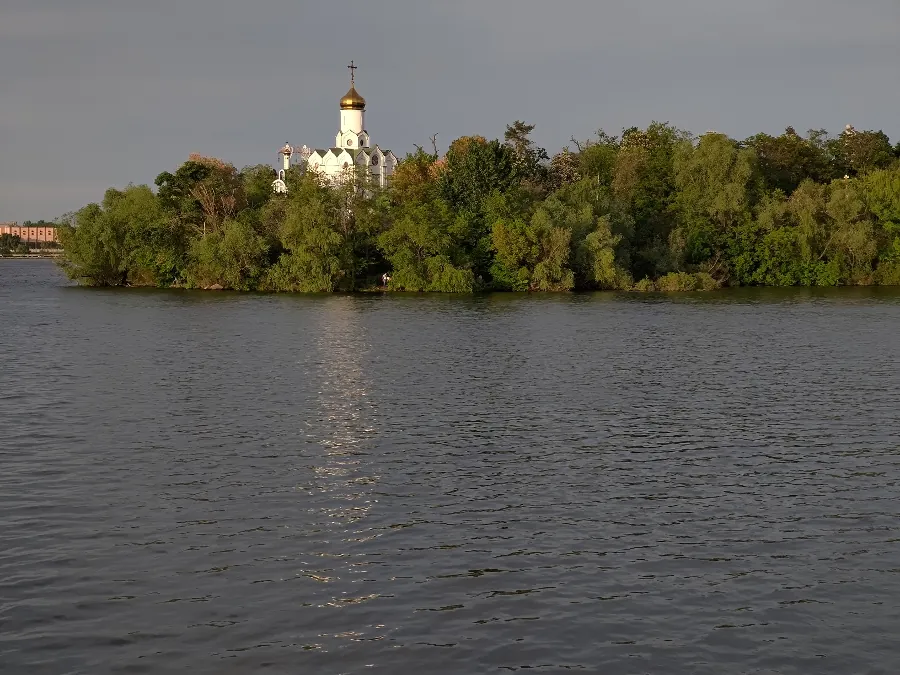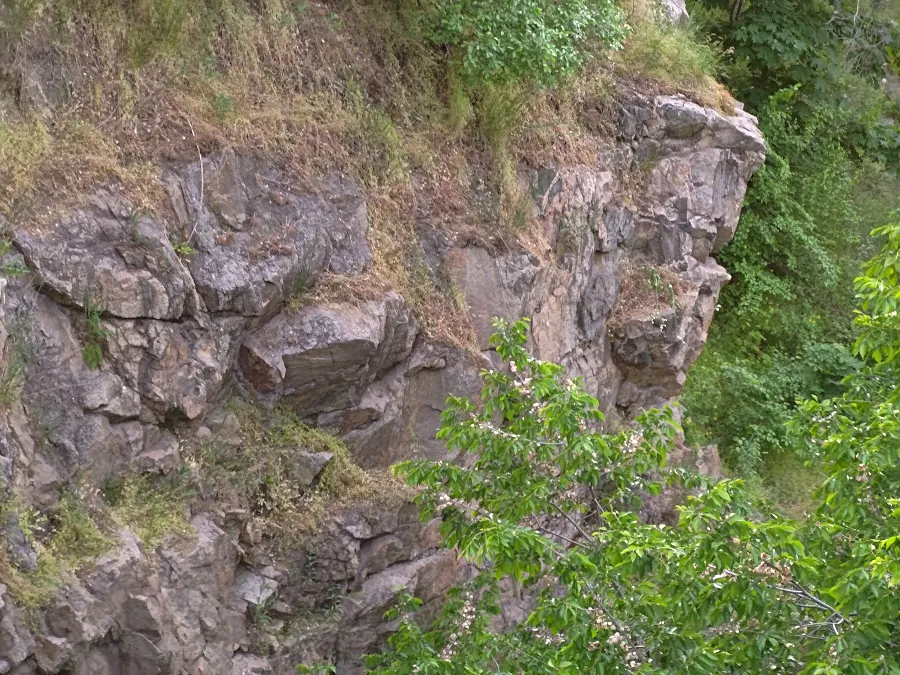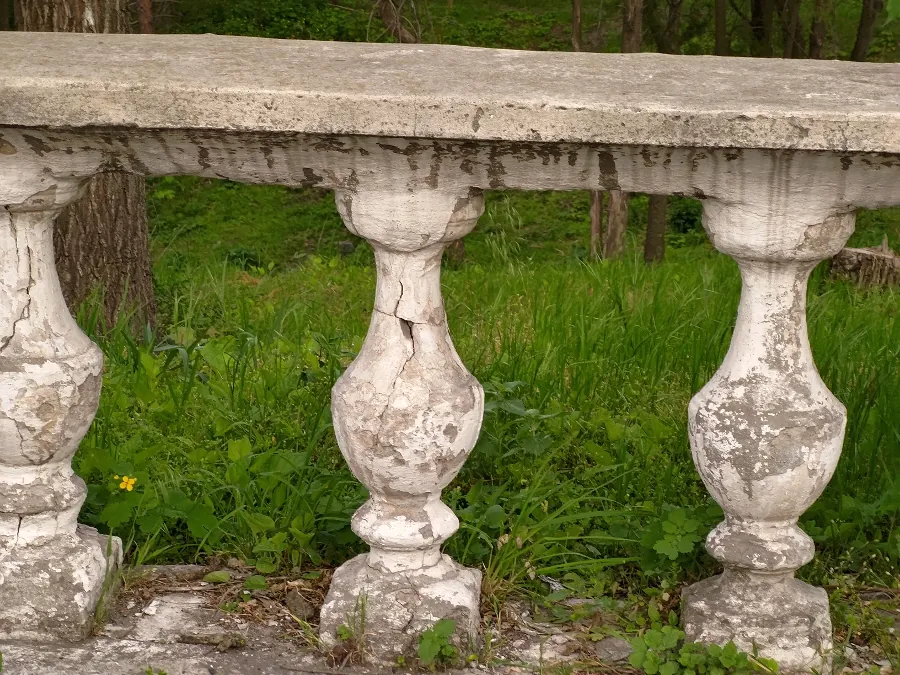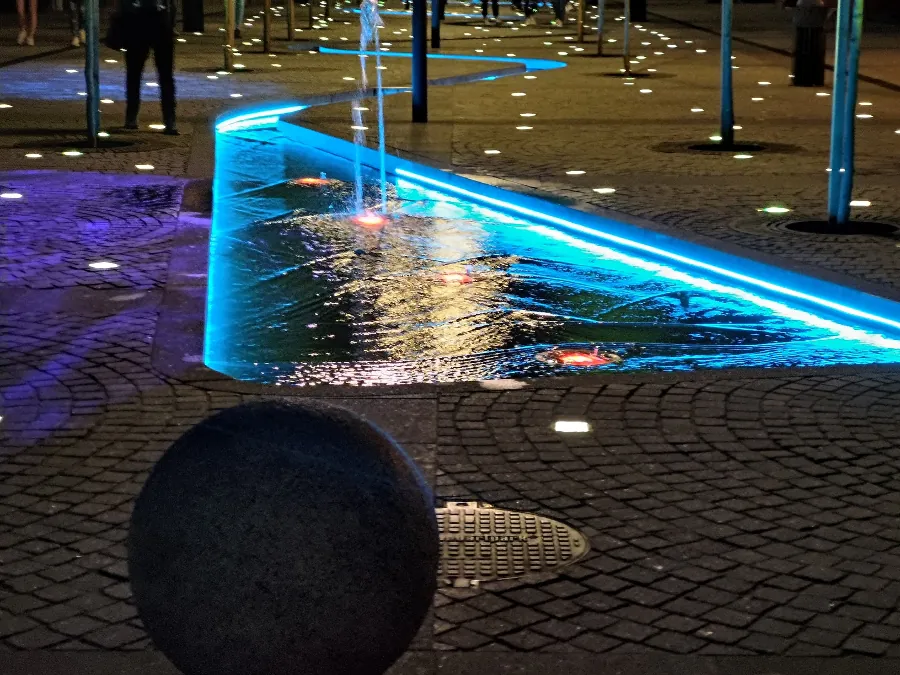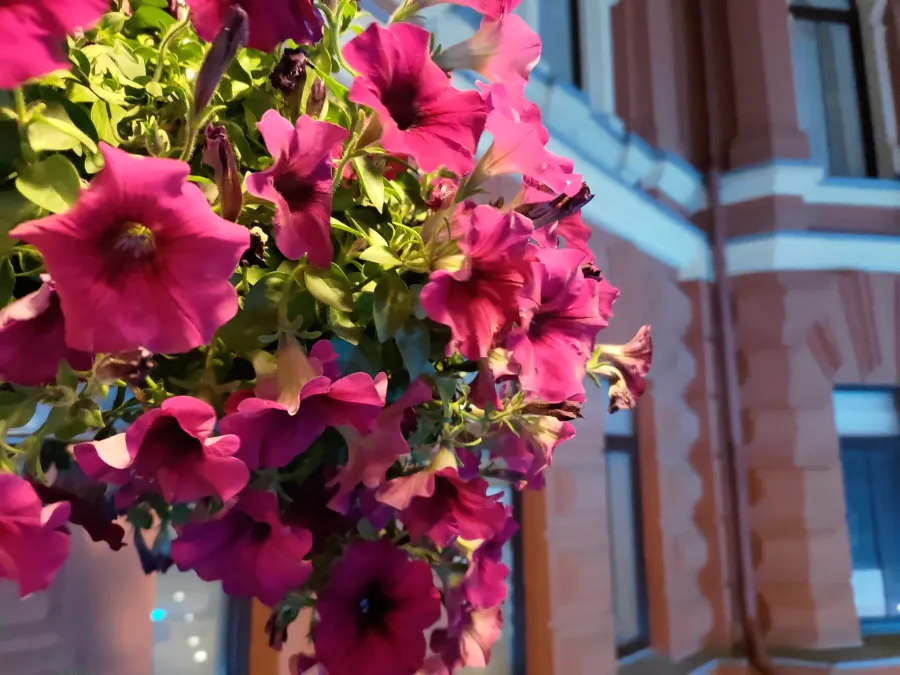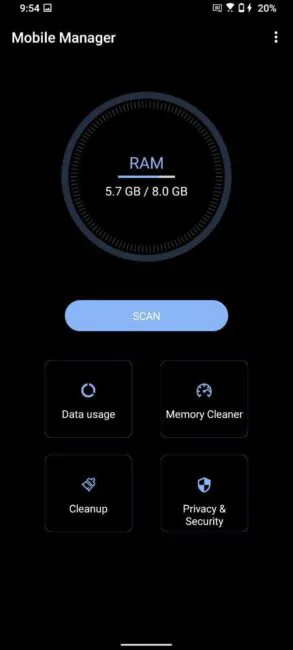© ROOT-NATION.com - Use of content is permitted with a backlink.
Not so long ago, the Taiwanese company ASUS introduced the 8th generation of its flagship Zenfone series, which included two models – the base Zenfone 8 and the Zenfone 8 Flip. The flip camera in ASUS smartphones debuted a couple of years ago with the Zenfone 6 series, then continued with the Zenfone 7 and has survived to this day. This is a pleasant surprise, since non-standard design solutions are not always reincarnated in the next generations of smartphones. Remember pop-up cameras, which eventually disappeared?
Compared to the Zenfone 7 generation, where both models had a rotating camera mechanism, this year the brand decided to give the user a choice – the line includes both a classic and a more exotic model. Today we will get acquainted with the latter.
Full specifications of the Zenfone 8 Flip
| NETWORK | Technology | GSM / HSPA / LTE / 5G |
|---|
| LAUNCH | Announced | 2021, May 12 |
|---|---|---|
| Status | Available. Released 2021, May 13 |
| BODY | Dimensions | 165 x 77.3 x 9.6 mm (6.50 x 3.04 x 0.38 in) |
|---|---|---|
| Weight | 230 g (8.11 oz) | |
| Build | Glass front (Gorilla Glass 6), glass back (Gorilla Glass 3), aluminum frame | |
| SIM | Dual SIM (Nano-SIM, dual stand-by) |
| DISPLAY | Type | Super AMOLED, 90Hz, HDR10+, 700 nits (HBM), 1000 nits (peak) |
|---|---|---|
| Size | 6.67 inches, 107.4 cm2 (~84.2% screen-to-body ratio) | |
| Resolution | 1080 x 2400 pixels, 20:9 ratio (~395 ppi density) | |
| Protection | Corning Gorilla Glass 6 | |
| Always-on display |
| PLATFORM | OS | Android 11, ZenUI 8 |
|---|---|---|
| Chipset | Qualcomm SM8350 Snapdragon 888 5G (5 nm) | |
| CPU | Octa-core (1×2.84 GHz Kryo 680 & 3×2.42 GHz Kryo 680 & 4×1.80 GHz Kryo 680) | |
| GPU | Adreno 660 |
| MEMORY | Card slot | microSDXC (dedicated slot) |
|---|---|---|
| Internal | 128GB 8GB RAM, 256GB 8GB RAM | |
| UFS 3.1 |
| MAIN CAMERA | Triple | 64 MP, f/1.8, 26mm (wide), 1/1.73″, 0.8µm, PDAF 8 MP, f/2.4, 80mm (telephoto), PDAF, 3x optical zoom 12 MP, f/2.2, 112˚, 14mm (ultrawide), 1/2.55″, 1.4µm, dual pixel PDAF |
|---|---|---|
| Features | Dual-LED flash, HDR, auto panorama (motorized rotation) | |
| Video | 8K@30fps, 4K@30/60/120fps, 1080p@30/60/240fps, 720p@480fps; gyro-EIS, HDR |
| SELFIE CAMERA | Triple | Motorized flip-up main camera module |
|---|---|---|
| Features | Dual-LED flash, HDR, auto panorama (motorized rotation) | |
| Video | 8K@30fps, 4K@30/60/120fps, 1080p@30/60/240fps, 720p@480fps; gyro-EIS, HDR |
| SOUND | Loudspeaker | Yes, with stereo speakers |
|---|---|---|
| 3.5mm jack | No | |
| 24-bit/192kHz audio |
| COMMS | WLAN | Wi-Fi 802.11 a/b/g/n/ac/6e, dual-band, Wi-Fi Direct, hotspot |
|---|---|---|
| Bluetooth | 5.2, A2DP, LE, aptX HD, aptX Adaptive | |
| GPS | Yes, with dual-band A-GPS, GLONASS, GALILEO, QZSS, NavIC, BDS (tri-band) | |
| NFC | Yes | |
| Radio | No | |
| USB | USB Type-C 2.0 |
| FEATURES | Sensors | Fingerprint (under display, optical), accelerometer, gyro, proximity, compass |
|---|
| BATTERY | Type | Li-Po 5000 mAh, non-removable |
|---|---|---|
| Charging | Fast charging 30W USB Power Delivery 3.0 |
Read also: ASUS ROG Zephyrus G14 2021 laptop review: Great, but not mind-blowing
Price and positioning
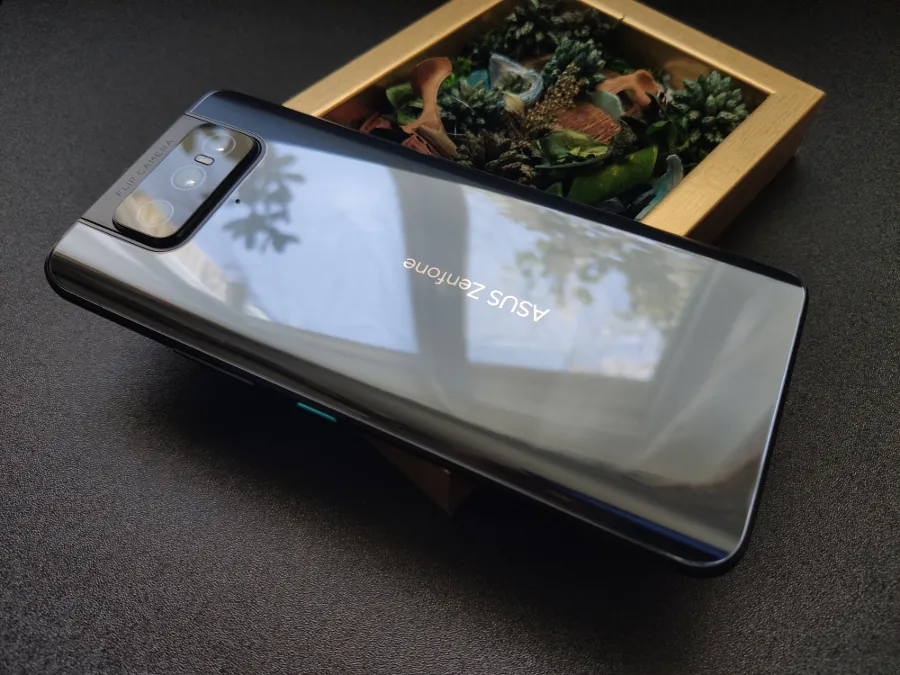
Over the years spent on the smartphone market, ASUS has retained two series of devices – the gaming ROG Phone and top-end, but more classy Zenfone. If the target audience of ROG Phone is mainly gamers, then Zenfone is more versatile. Since the smartphone is a flagship, the price is appropriate – somewhere around $982. What does ASUS offer us for this money?
Zenfone 8 Flip: What’s in the box
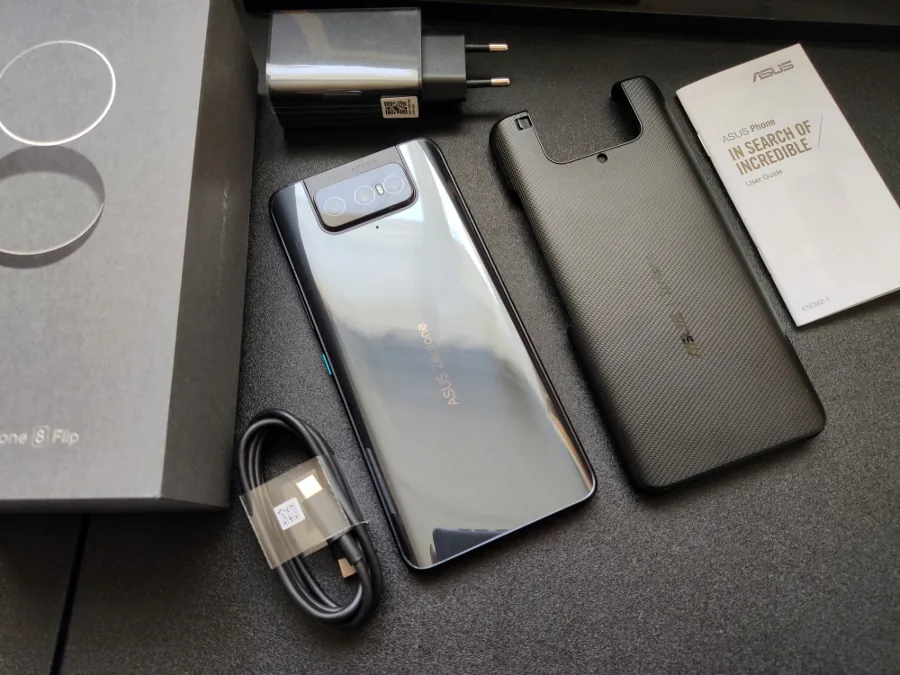
The Zenfone 8 Flip packaging is a minimalistic gray box made of matte cardboard with a stylistic number 8 on the front. Inside is a smartphone, a 30-watt charger, a Type-C to Type-C cable, a SIM eject tool (there is a slot for 3 positions), some accompanying literature, and a protective bumper.
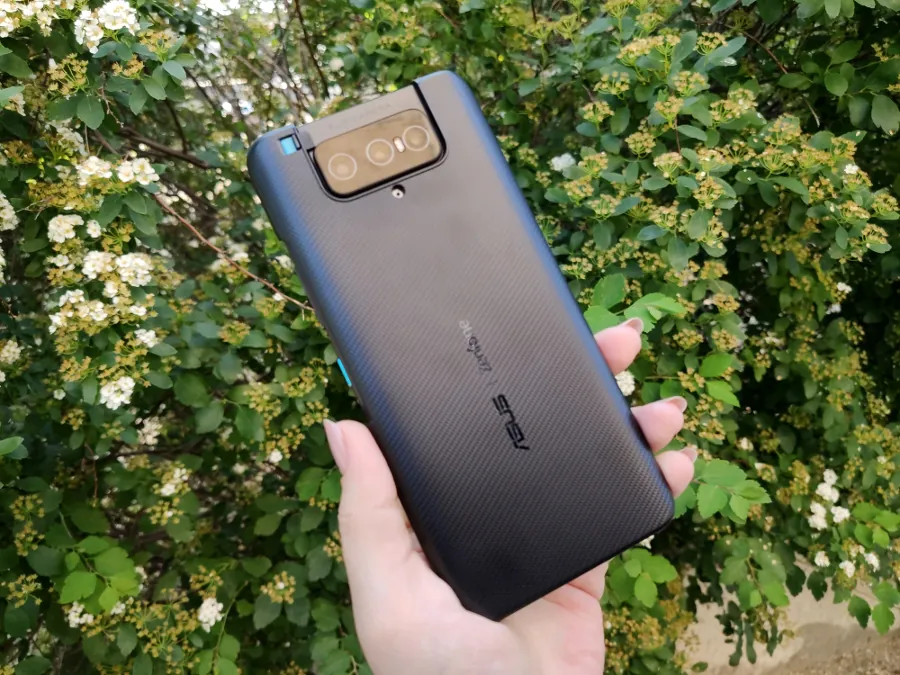
The cover is made of dense black plastic and has a fine cellular texture. In the case, the smartphone seems more bulky, its appearance, in my opinion, is simplified, but fingerprints are not visible, which perfectly accumulate on the glass case. Another advantage of the bumper is a small latch that fixes the camera in the closed position.
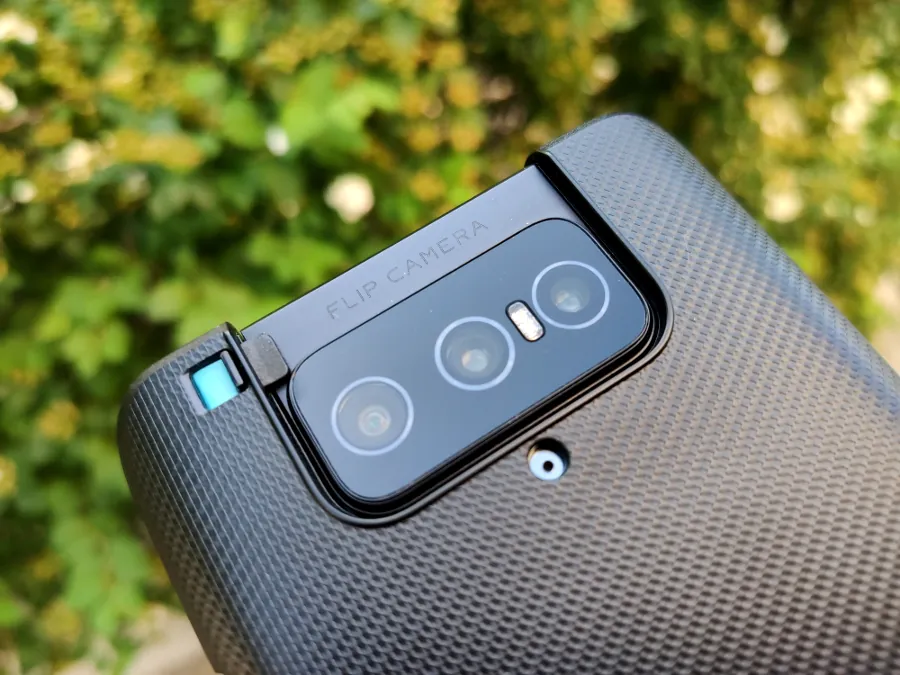
Design, materials and build quality
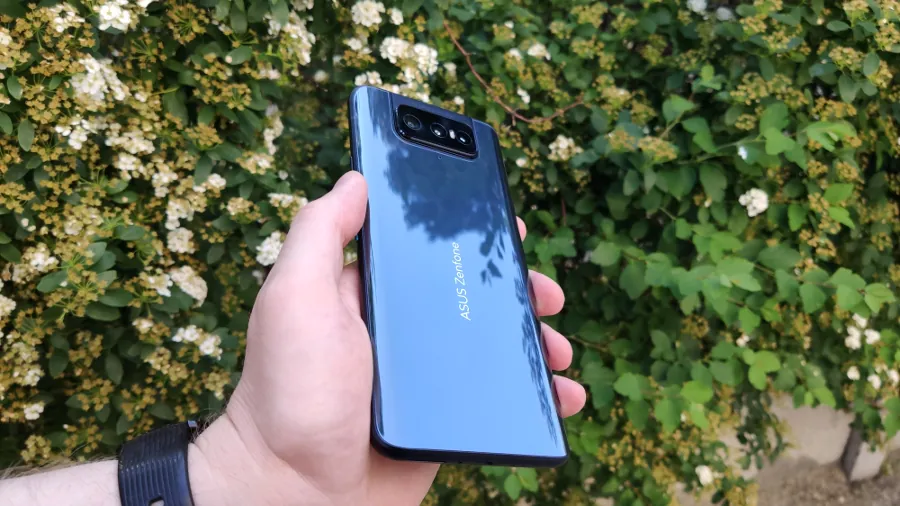
The Zenfone 8 Flip’s design hasn’t changed much since the last generation. The back, like the front, is glass, and the edges are made of metal, but they have plastic inserts in the places for the antennas. The back has rounding on the sides. At the back, approximately in the center, there is the brand logo and the name of the series to which our character belongs, and above, above the hole for one of the microphones, is one of the main assets of the Zenfone 8 Flip – a trio of cameras on a rotating mechanism with a barely noticeable Flip Camera mark. The retractable camera block is also made of metal and glass and protrudes slightly above the body, which is why when the device lies on a horizontal surface, the upper part is slightly raised. However, you can hide it a little with a protective cover.
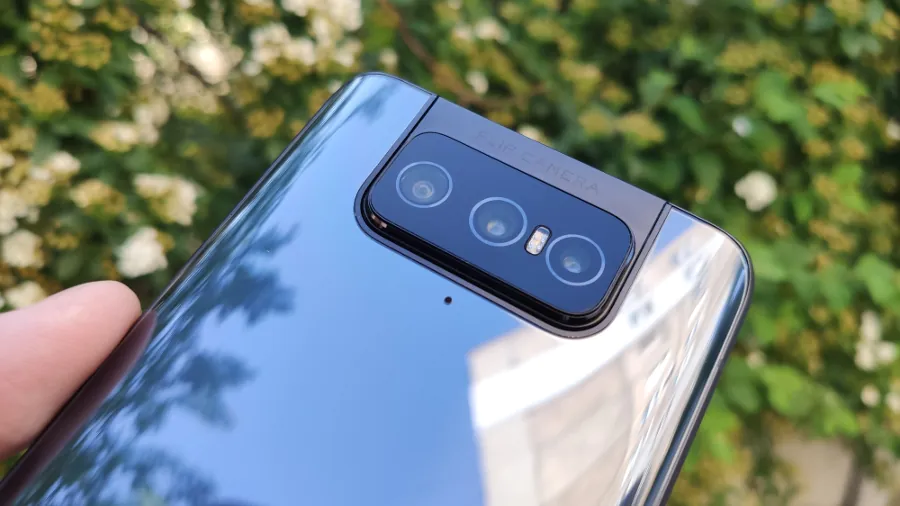
Since we started talking about the most interesting thing – the camera – then, perhaps, we will dwell on it in more detail. In the closed position, it does not attract much attention – it looks like a usual camera.
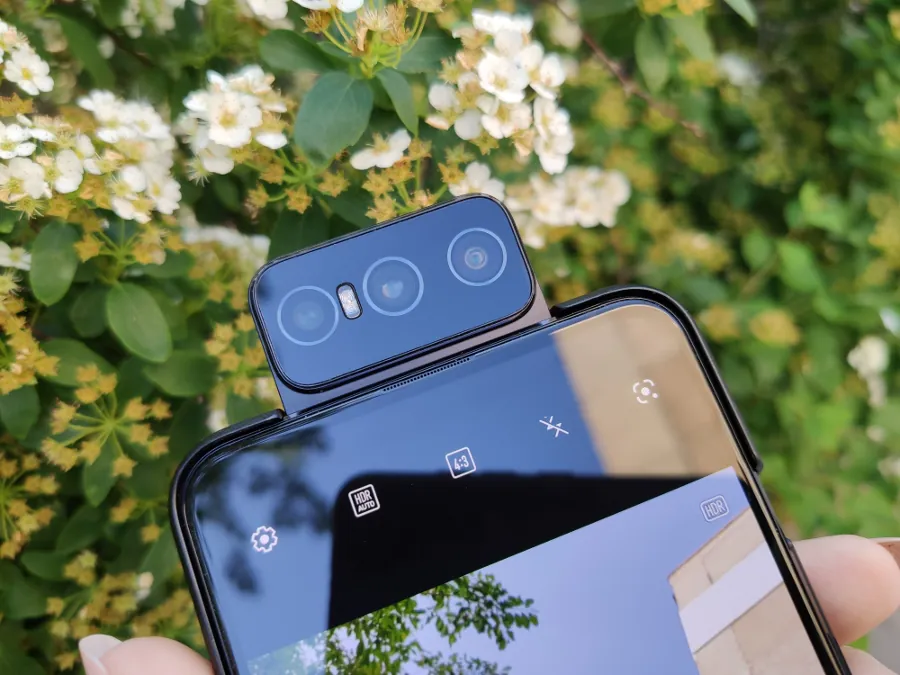
In selfie mode, when the camera opens 180°, the camera unit protrudes a couple of centimeters above the body. But there are also intermediate recline angles that are used for general photography. Thanks to this, you can shoot familiar objects from unusual angles or create, for example, interesting “automatic” panoramas, which I will discuss later. Separately, it is worth noting the pleasant vibration and sound emitted by the motor of the mechanism – very interesting sensations, which makes you want to open and close the module. If we talk about the resource of the mechanism, then, according to the manufacturer, it is designed for 300,000 uses or 5 years of operation with 150 operations per day. It sounds pretty good, but aimlessly playing with the it is still not worth it. Although at first it is difficult to resist.
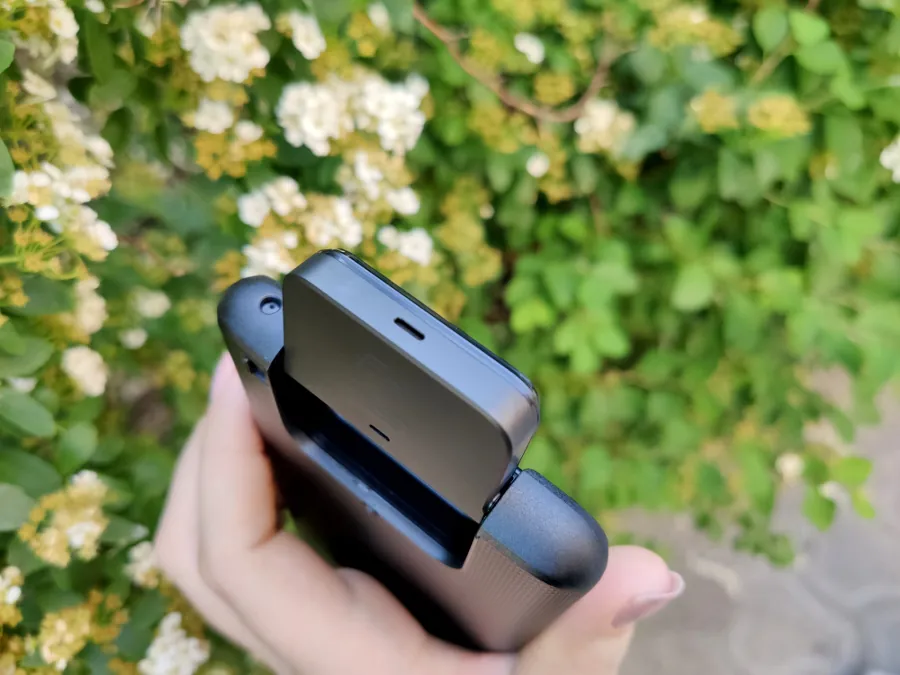
The smartphone comes in two colors: Galactic Black, which we have on our review, and Glacier Silver. Despite the fact that the word “Black” appears in the name, it is rather dark gray with a cold blue undertone. No gradients, just pure color and glossy finish. In general, the Zenfone 8 Flip looks monochrome and discreet, with only a bright turquoise power button adding variety.
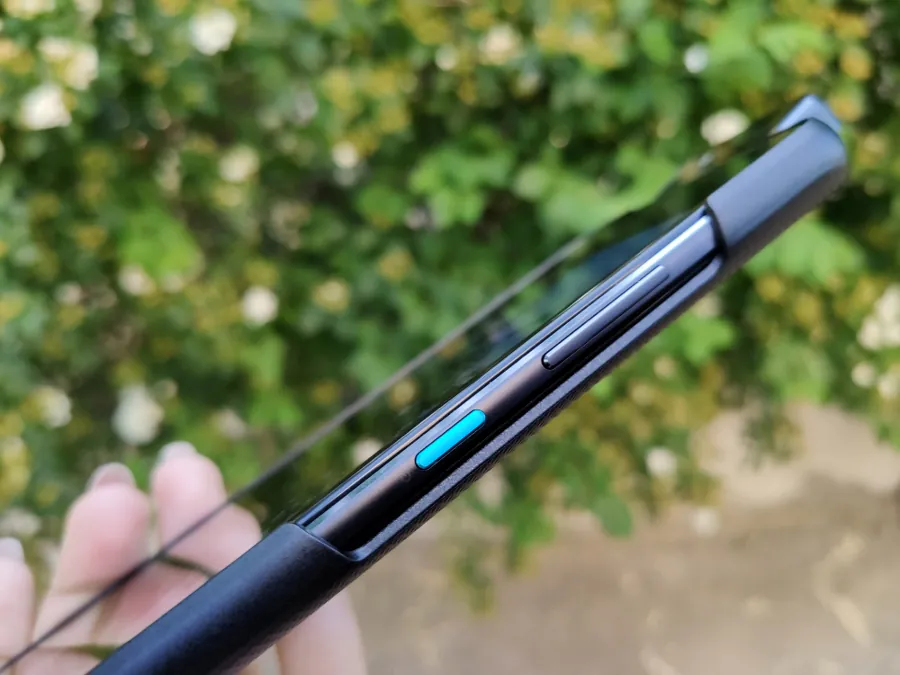
The dark glass panel is beautiful, but it is a nightmare for the perfectionist, since the fingerprints are so noticeable.
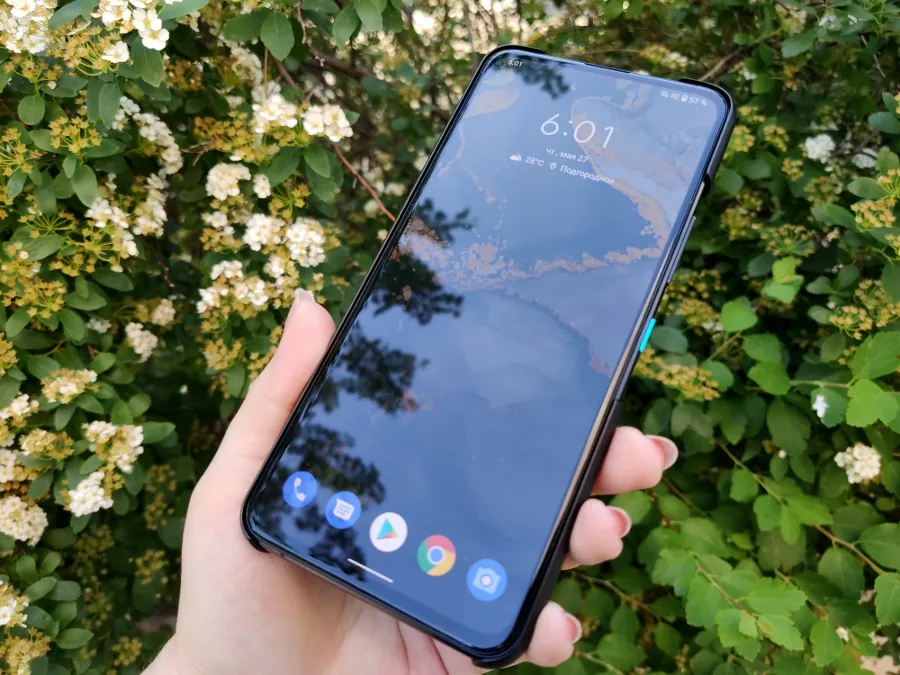
Due to the fact that the main camera works as a selfie camera as well, there are no distracting notches and the screen occupies 92% of the front panel. The bezels around the display are small, but still quite noticeable. At the junction between the screen and the top, you can see the earpiece speaker.
It is worth noting that, unlike the base Zenfone 8, the Flip version is not protected from dust and water.
The layout
The main elements are arranged exactly like in the previous generation of Zenfone. On the top there is nothing but an auxiliary microphone. On the opposite side, there is the main speaker, a microphone, Type-C charging port and LED indicator. There is no 3.5 mm audio port.
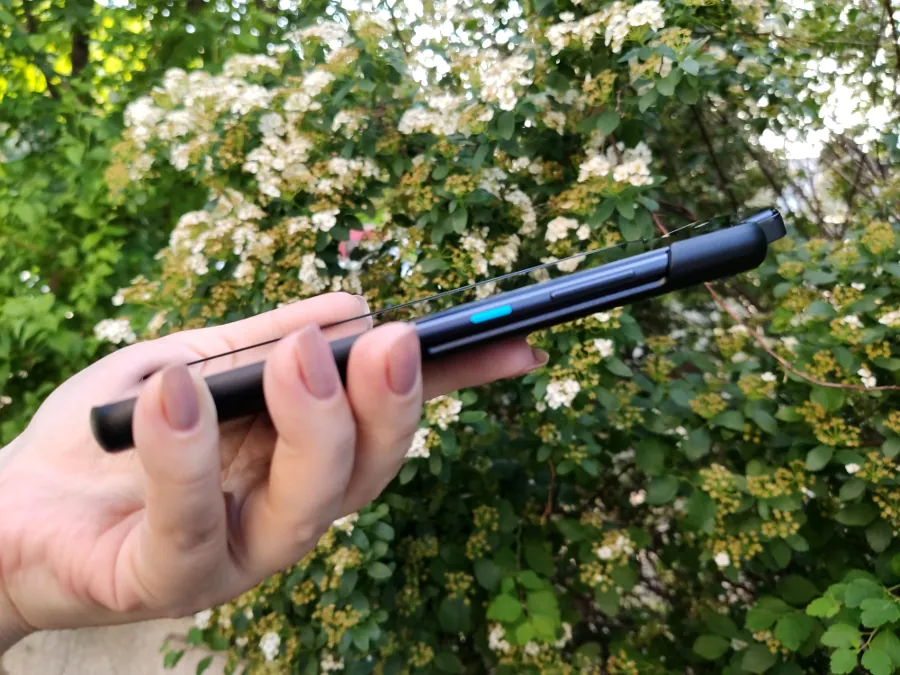
To the left of the display there is a full-fledged slot for a pair of SIM cards and a memory card. On the right are the volume buttons and the power key, which is highlighted in turquoise. While in the Zenfone 7 the fingerprint scanner was combined with the power button, now the fingerprint sensor is located in the screen. By the way, the power button can be set to quickly access any app by double or long press, which is not particularly surprising today, but still quite convenient.
If we talk about the location of the components, the developers took into account the format of the device and placed them conveniently. With a standard grip, the power button falls right under your right thumb. By slightly changing the grip, you can easily reach the fingerprint scanner with the same finger. In this regard, there are no issues.
Ergonomics
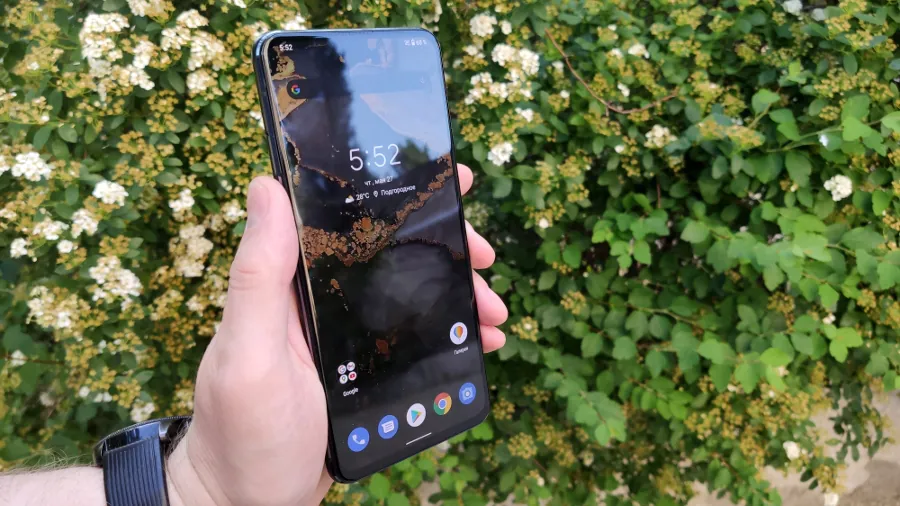
Everything seems to be great in design, the build quality and materials are at the highest level, but, nevertheless, there are issues. I’m talking about dimensions and weight, which largely affect ergonomics. Of course, with a 6.67-inch display, no one expects the device to be compact. But don’t forget about the thickness of the case and the fact that it weights 230 g. 230 g doesn’t seem much, but in the hand, the smartphone feels heavy, bulky and uncomfortable. For reference: the Zenfone 8 has a 5.9-inch screen and weighs 169 g. This proportion, in my opinion, is much more practical and versatile.
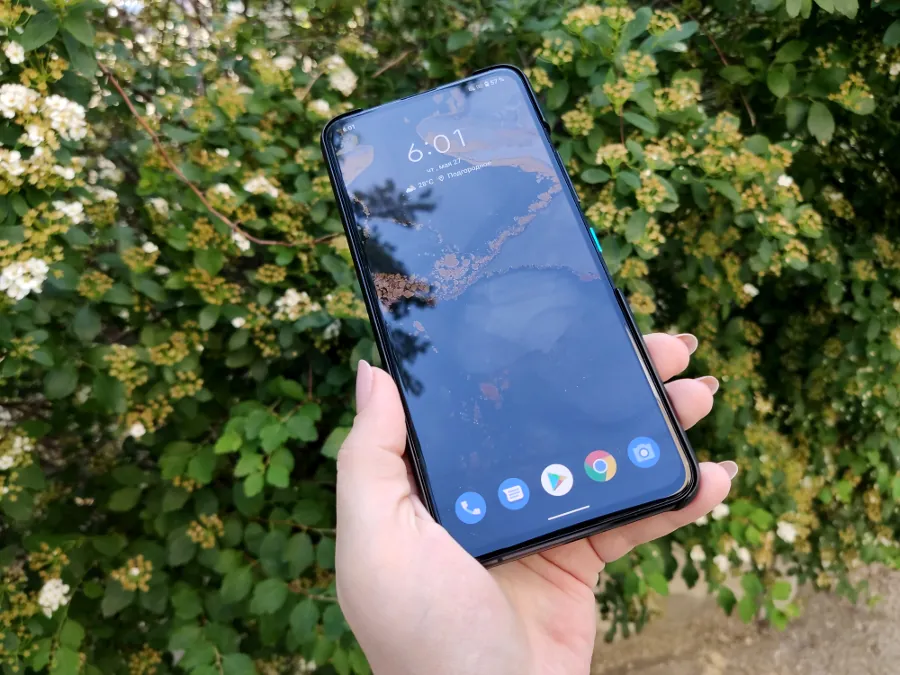
We should also note the shift in balance when the camera is tilted. Because of this, the device, which is already not the most comfortable to hold, gets even more inconvenient. You always fear you’ll drop the Zenfone 8 Flip. Thank god there’s an emergency “folding” of the camera in the event of a fall (checked on the sofa – it works!), But this is unlikely to save from other possible damage, especially if the smartphone is without a case.
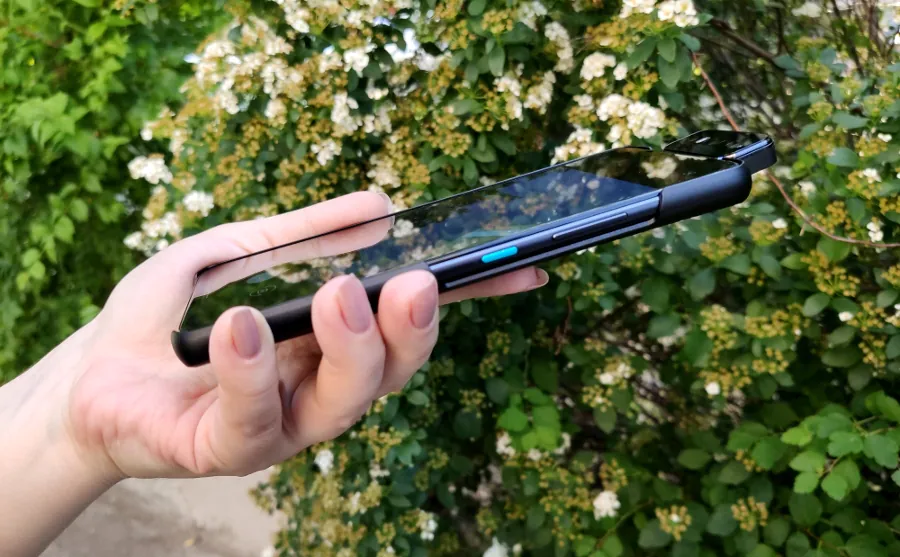
Display
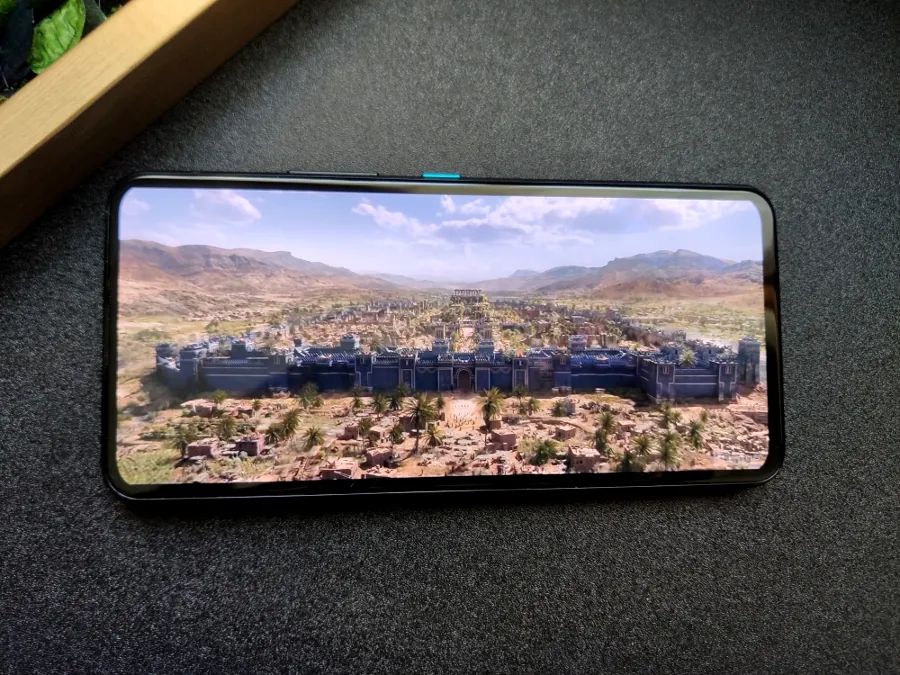
Technically, the Zenfone 8 Flip’s screen is the same as its predecessor, except that the fingerprint scanner is now in the display. One of its main advantages is the absence of a notch for the front-facing camera, which creates the impression of integrity.
Here we have a 6.67-inch SuperAMOLED matrix with a resolution of 2400×1080 (Full HD+) and a refresh rate of 90 Hz. Of course, this is not 120 Hz, which many flagships offer, but 90 Hz is quite great as well. In the settings, you can select not only 60 or 90 Hz, but also the mode of automatic adjustment of the refresh rate. It feels like in this mode the screen almost always (or in most cases) works in 90 Hz. For some apps, it reduces the refresh rate, but this is not easy to track, since the difference is not that striking. In addition, the screen supports HDR10+ and covers 110% of the DCI-P3 color space.
The screen settings are very extensive. Basic functionality is provided by adaptive brightness, night mode, the ability to switch to a dark theme and set up Always-On. There are several color rendering modes that can be found in the Splendid settings. There are several presets: default, natural, cinematic, standard and custom mode, for which there is a slider for adjusting the color intensity. In each of these modes, you can also change the color temperature.
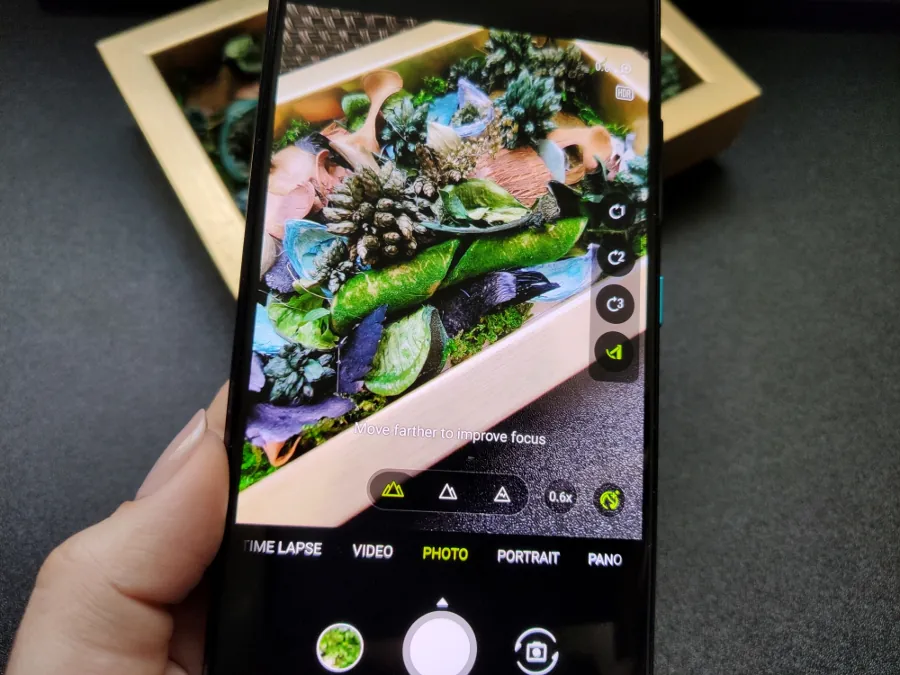
You can change the font, the color of system icons and the shape of app shortcuts, set an individual scale for each individual app, set the style of the power button menu, customize the icons, set the animation speed, enable gesture control or navigation bar and customize the LED indicator. A lot has been taken into account, thanks to which you can customize the operation of the display and interface to suit any requirements.
The overall impressions are very good. The screen remains readable when exposed to direct sunlight (the screen does not fade), there are excellent viewing angles, even by default, the display offers high contrast and pleasant color reproduction, so you don’t really want to adjust it in the settings.
Read also:
- ASUS ROG Strix SCAR 15 G533 Review: Superb Gaming Laptop
- ASUS VivoBook S15 M533IA review. Metal-clad mid-ranger
Hardware and performance of the Zenfone 8 Flip
The smartphone runs on Qualcomm’s fastest chipset, Snapdragon 888. There are no problems at all with performance, multitasking and games. Everything flies on the Zenfone 8 Flip, regardless of the task. In games, the smartphone is doing well on all settings. The case heats up slightly, but after an hour of playing PUBG, it only warmed up to 39°.
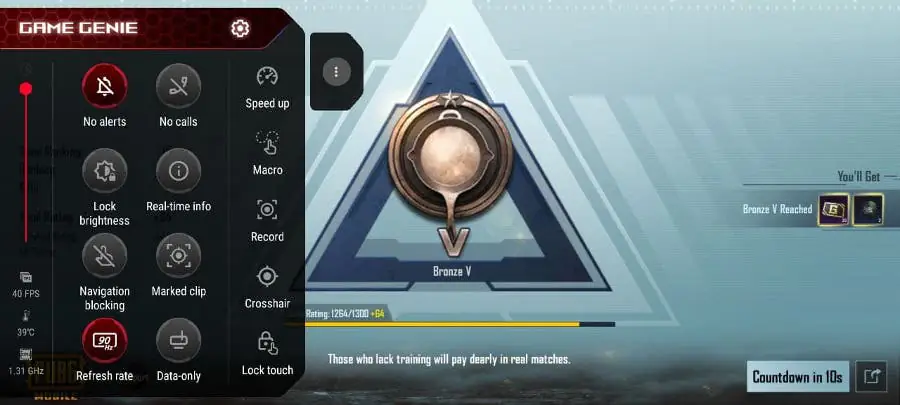
The graphics are supported by the Adreno 660 accelerator, the LPDDR5 RAM is 8 GB, and the storage (UFS 3.1) is 256 GB. Don’t forget about the support for memory cards up to 2 TB. It has it all.
Zenfone 8 Flip: Cameras
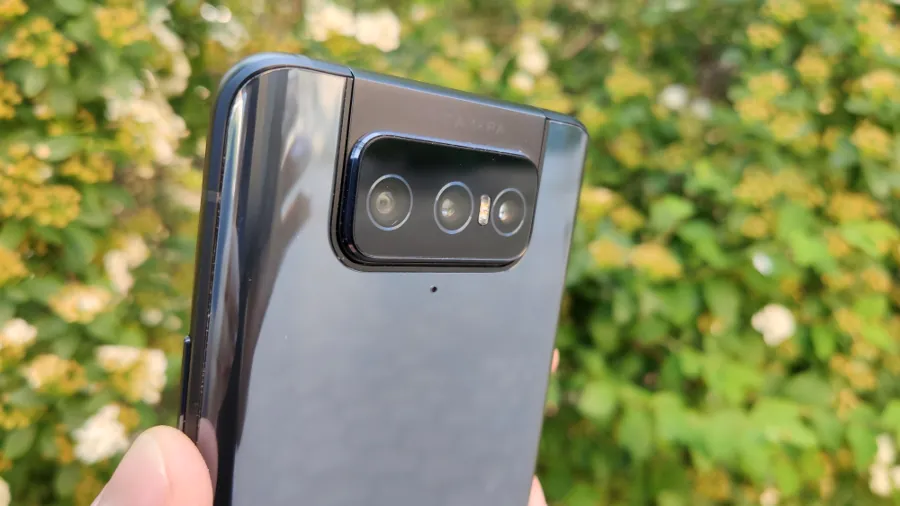
Perhaps the most interesting thing about the Zenfone 8 Flip is, of course, the camera. The camera has 5 automatic positions: closed, 3 intermediate ones and fully open (180°) for selfies. However, nothing prevents you from adjusting the angle manually, the mechanism provides for this and does not negatively affect performance. For those who are fond of mobile photography, this solution allows you to experiment with camera angles in photos and videos and, of course, get high-quality selfies.
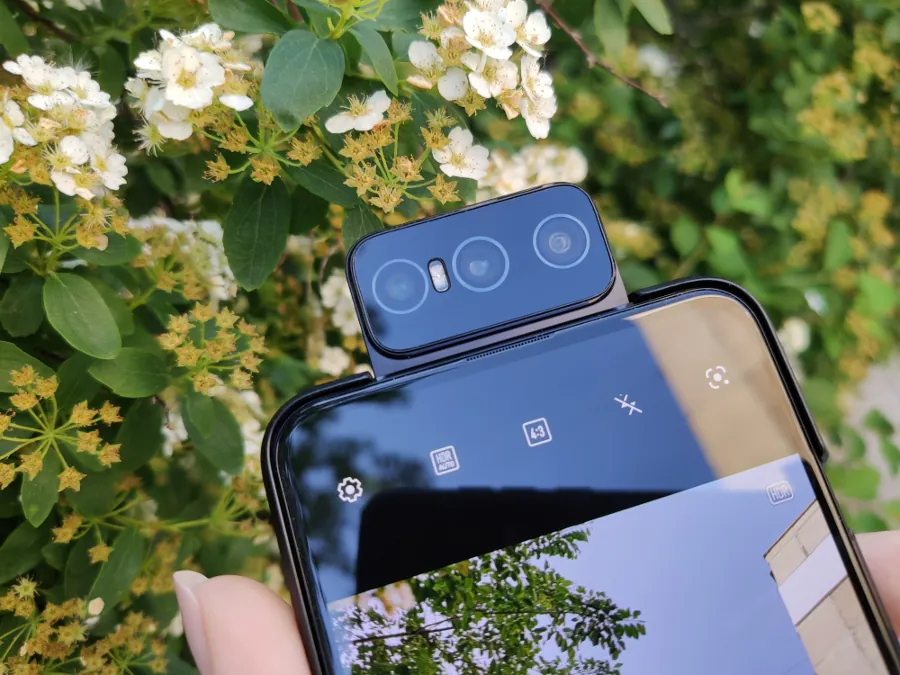
Let’s briefly go over the numbers. The main sensor here is a 64-megapixel Sony IMX686 (actual resolution 16 megapixels) with a viewing angle of 78.3°, f/1.8 light sensitivity, autofocus and software stabilization mode called HyperSteady, as well as a wide-angle Sony IMX363 12 megapixels module with f/2.2 aperture and a 8 MP telephoto lens with 3x optical and 12x digital zoom. Surprisingly, though the Zenfone 8 Flip belongs to the flagships, not even the main sensor has optical stabilization.
The following modes are available for taking photos in the camera app: photo, manual and night modes, portrait, document and panorama. Panorama mode deserves special attention, as it unleashes the potential of a flip camera. To take a panoramic shot on the Zenfone 8 Flip, you don’t have to twist your smartphone, the swivel mechanism will do it for you. As a result, we get a “long” image with practically no obvious traces of merging. Unusual but very cool. This it is applicable in both horizontal and vertical photography. And you also can get interesting panoramic selfies.
For videos, there are modes of fast (up to 4K at 120 fps) and slow motion, classic Video mode (up to 8K), a Pro mode and object tracking mode. There is also a wind noise filter during recording and acoustic focusing, which will allow you to focus on the sound source in the video. Another interesting feature is free focusing, which will help to reveal the camera’s abilities. In this mode, you can select any object if is in the frame, after which the camera will smoothly move it to the center of the frame and concentrate on it.
In the settings, you can edit the location of the modes, select the needed format, set the command to the physical volume buttons, turn on the grid, preliminary autofocus, and so on. Of course, there is Google Lens and HDR.
What is the quality of the images? Daytime photos from the Zenfone 8 Flip are at a very flagship level, and this is true for each of the available modules. The pics are characterized by excellent detailing, contrast and clarity, color reproduction is natural and pleasing to the eye. The wide angle, of course, covers a larger angle, but the perspective is minimally affected. The telephoto module with 3x zoom is great as well – the optics do an excellent job of zooming in without noticeable loss of quality. And the digital zoom is as good as you can expect.
But at night everything just stops working. The wide angle is the worst of all: it blurs everything and smooths out any textures and noise, which means there is no clarity and the photos look plain bad. The 8-megapixel sensor tries its best to convey contrast, but the pictures lack detail and volume. The main sensor copes best with night shooting. Not perfect, but not bad either. Examples of photos can be found below.
The main module:
Photos from the main sensor in full resolution
Wide angle:
Examples of photos from the wide-angle sensor in full resolution
Telephoto:
Examples of photos from telephoto module in full resolution
Unlocking
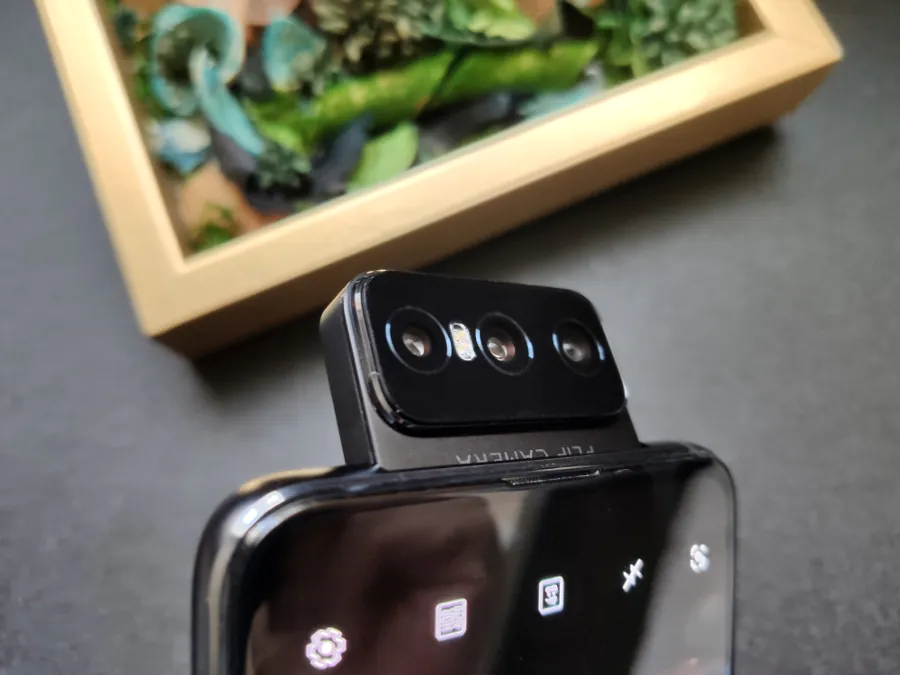
As mentioned above, the fingerprint sensor in the Zenfone 8 Flip is located under the screen. It works the same as on most smartphones with an in-screen fingerprint scanner – good, pretty fast, but sometimes the unlocking does not happen the first time. The technology is still not perfect, what can you do.
But the face recognition is lacking. Since it’s a smartphone with no conventional front-facing camera, it takes its time. I did not have any complaints about it, it works quite accurately, while not being tied to lighting. The scanner may think a little in low light, but the recognition time is normal. The only thing I would like to change is to add automatic activation of the camera when unlocking, but for now I have to swipe across the screen after it wakes up.
The Zenfone 8 Flip battery life

With a 5000 mAh battery, the Zenfone 8 Flip lasts up to 2 days on a single charge. But this is with no games or YouTube binges. The smartphone supports fast 30-watt charging, but the charging time is not that fast. So, for example, from 14% to 94% the smartphone charges in 1 hour 10 minutes.
The Zenfone 8 Flip offers flexible power consumption settings. In the corresponding menu in the settings, the following modes are provided: High performance, Dynamic, Durable and Ultra Durable (energy-saving), as well as an Advanced mode in which you can adjust the energy consumption manually by key points (limiting the performance of GPU, thermal limit, setting the refresh rate, etc.).
In addition, there’s battery optimization. For example, you can set the charge limit at 80% or 90%, as well as continuous charging, which will limit the charge rate to protect the battery. Wireless charging is sadly missing.
Sound and communication
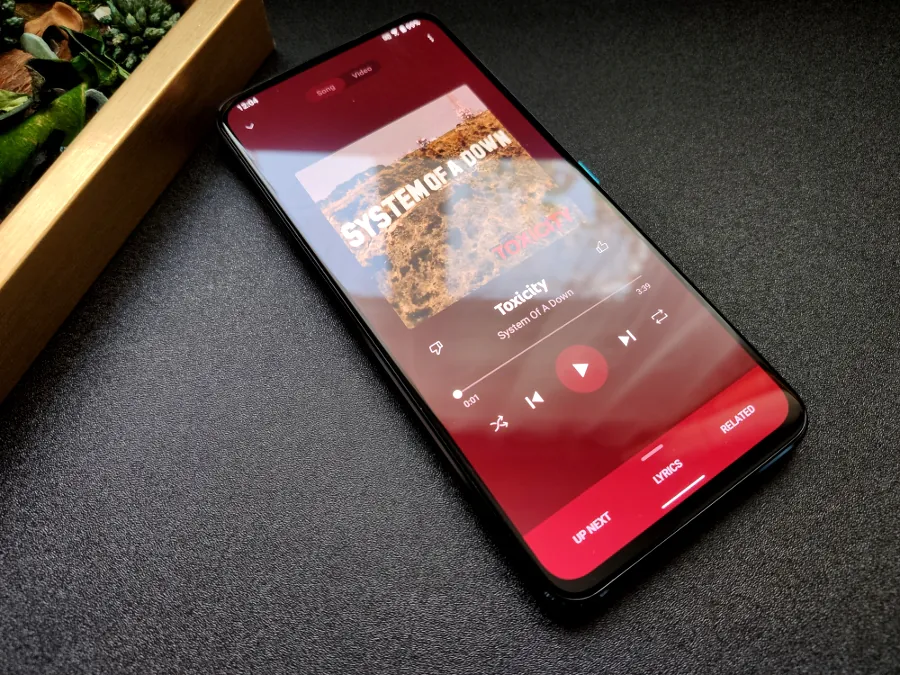
Today, stereo sound is the norm for a flagship. In theZenfone 8 Flip, it is provided by the main speaker, which is traditionally located at the bottom, and the earpiece speaker. Of course, the disproportionality of the speakers affects the sound (the lower one is obviously more powerful), but the stereo effect is still present.
The phone is also very loud. There’s a Smart Ringtone feature – a mode in which the ringtone volume depends on the background noise. The higher the noise level around, the louder the ringtone will be. In addition, in the settings you can find the Audio Masters equalizer, which will allow you to adjust the sound for each type of content (games, movies or music) and separately for the speakers.
The phone supports Wi-Fi 6, Bluetooth 5.2, NFC and a stack of satellite navigation systems: GPS, GLONASS, BDS, GALILEO, QZSS, NavIC. It supports 5G as well.
Software
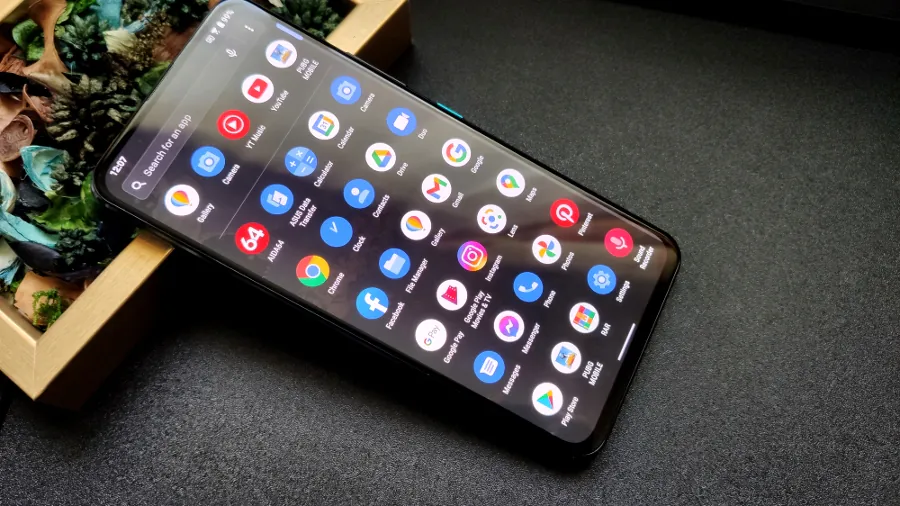
The software part of Zenfone 8 Flip is represented by Android 11 with a proprietary Zen UI 8 shell. Unlike the shells of various Chinese brands, Zen UI has a lot in common with the “pure” Android – the smartphone is not burdened with third-party software, everything is concise, simple and… very multifunctional. You can customize an incredible number of functions – from managing power saving modes to choosing the color and shape of app icons.
I talked about the key features in the relevant sections of the review, but there is more:
- OptiFlex is a mode that automatically analyzes which apps to close to save power, and which ones to leave in the background to load them quickly (the analysis is based on user habits);
- Mobile Manager allows you to view the consumed traffic, clean memory and scan the device for malicious or suspicious files;
- Game Genie is a multifunctional game mode;
- Twin Apps is for creating clones of apps and messengers for multiple accounts;
- Lock screen gestures helps to quickly launch apps directly from the locked screen to open certain apps.
The experience of interacting with Zen UI is the most positive – its functionality is extensive.
Verdict
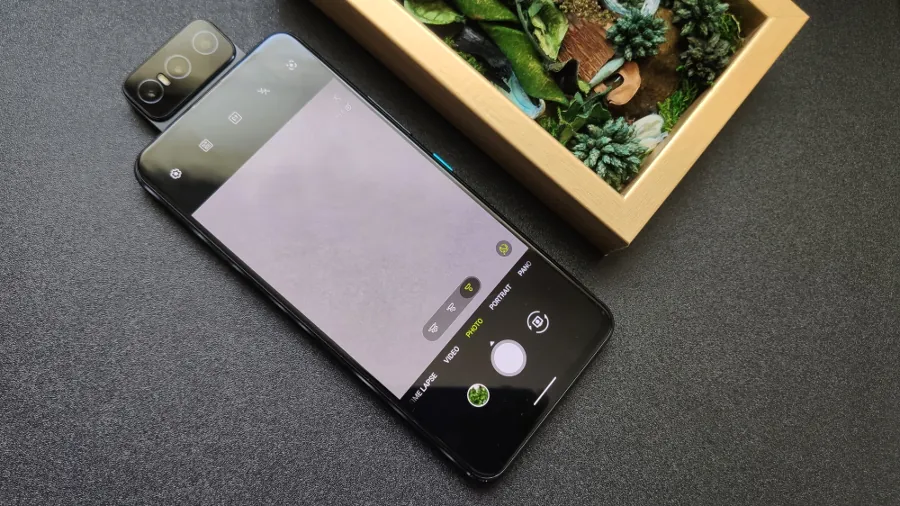
The release of the Zenfone 8 Flip suggests that this smartphone format is successful enough to warrant a third iteration of the flip camera design. On the other hand, this year the company decided to play it safe and presented the Zenfone 8 line with both the Flip and conventional cameras.
What do we get as a result? Technically speaking, the Zenfone 8 Flip hasn’t strayed that far from its predecessor. When we compare it directly with the Zenfone 7 Pro, we see the same flip camera with the same characteristics, the same display and battery life. The hardware was improved and, accordingly, the software refreshed, but some issues remained unresolved. This concerns water and dust resistance, optical stabilization, support for wireless charging and increased charging speed, as well as ergonomics.
If we talk about the target audience, then the Zenfone 8 Flip will surely appeal to those who love to shoot both photos and videos, and are looking for new opportunities in mobile photography. Or people tired of classic smartphones who want something interesting, but can’t spend money on the Fold. Otherwise, this is a quite decent device with a pleasant display, excellent performance and, yes, a good camera.

Subscribe to our accounts:


